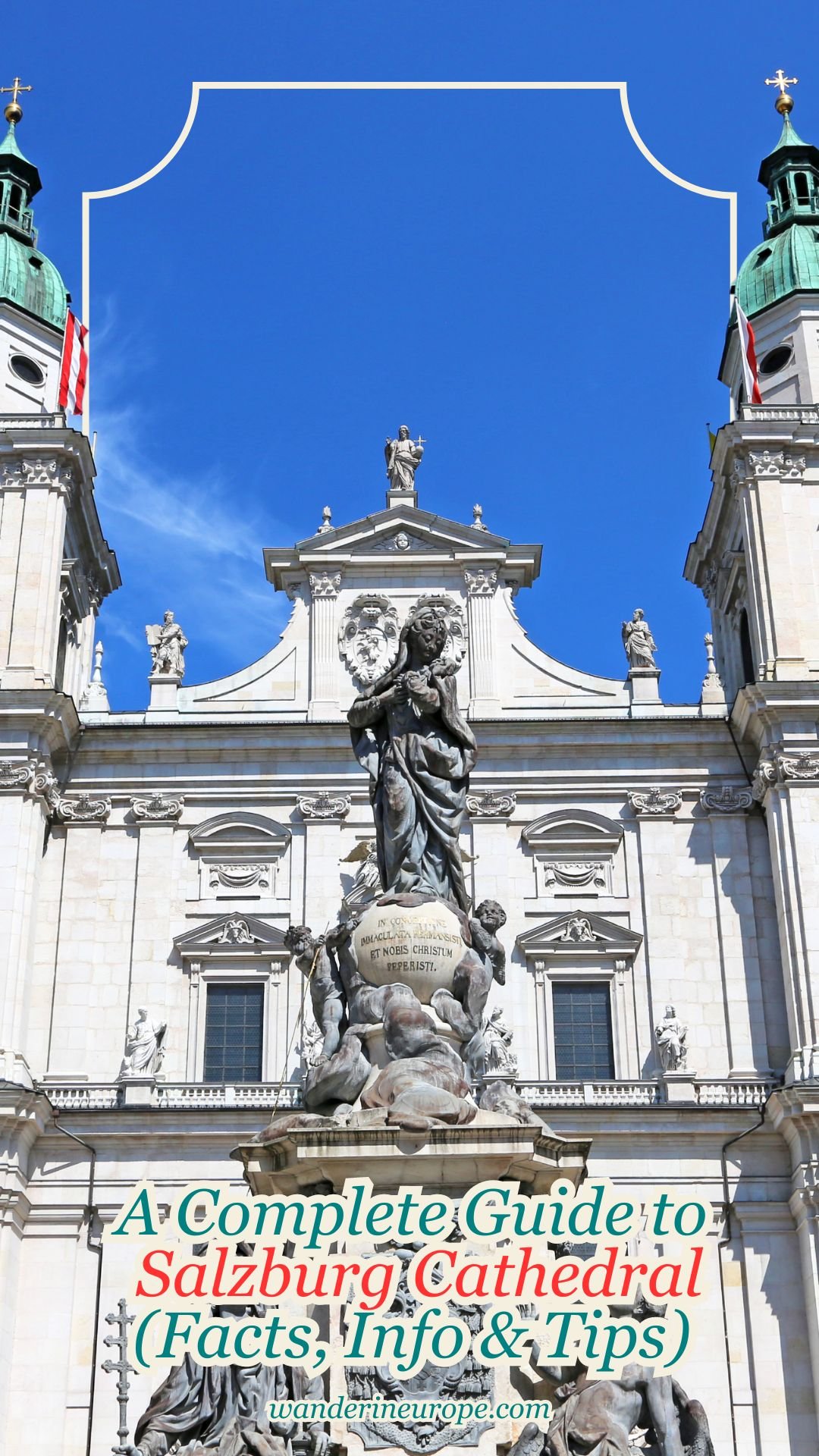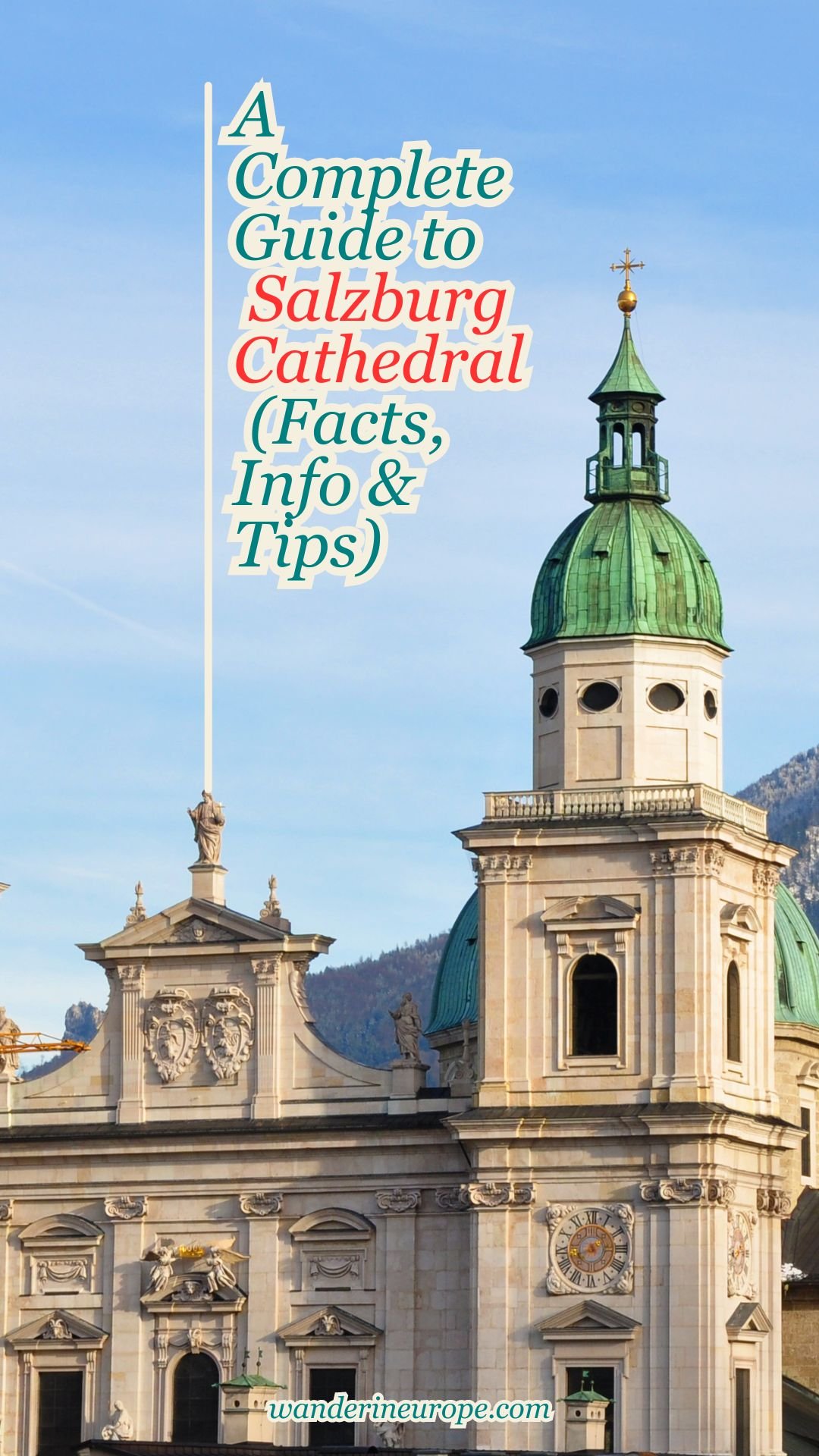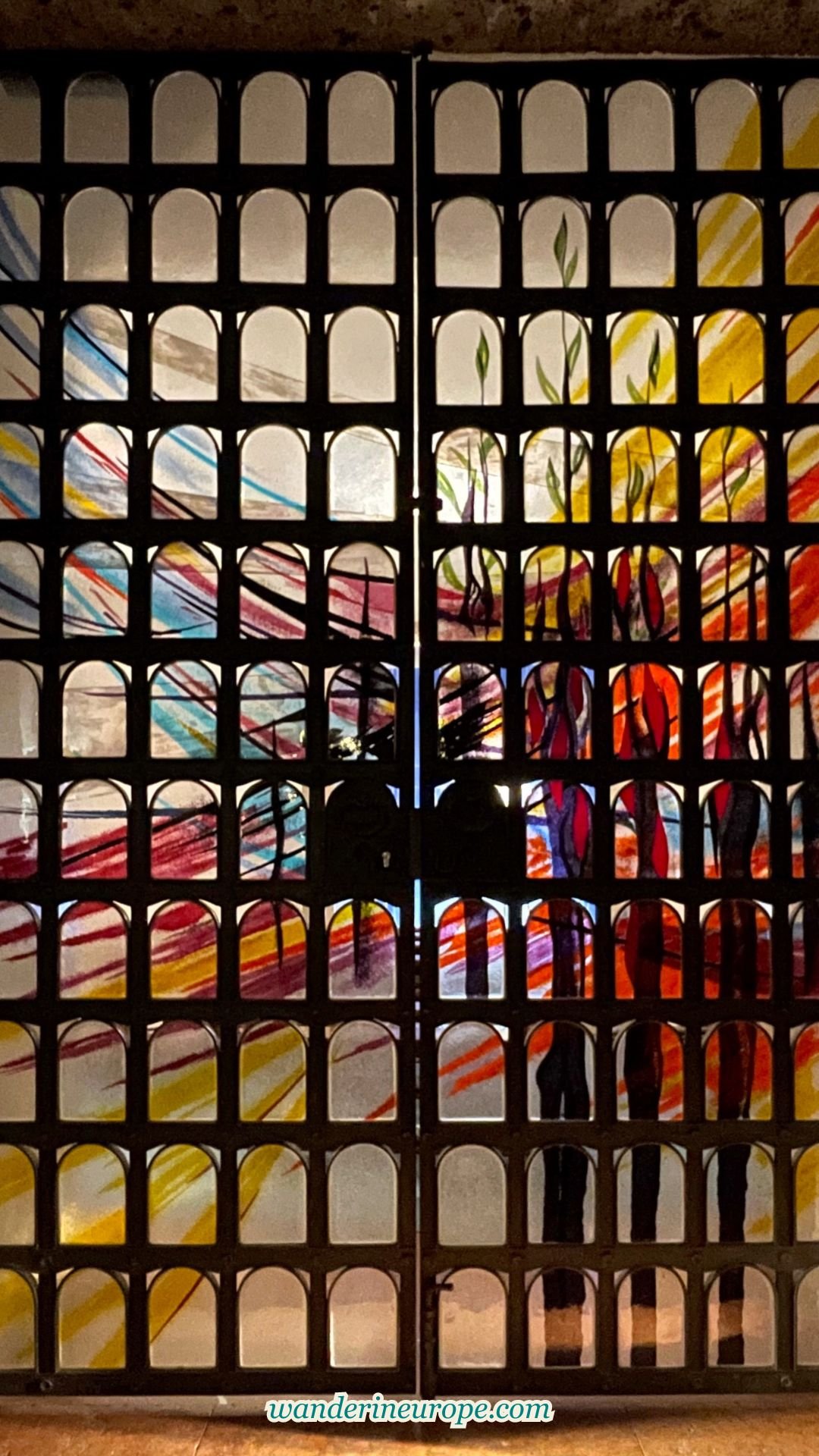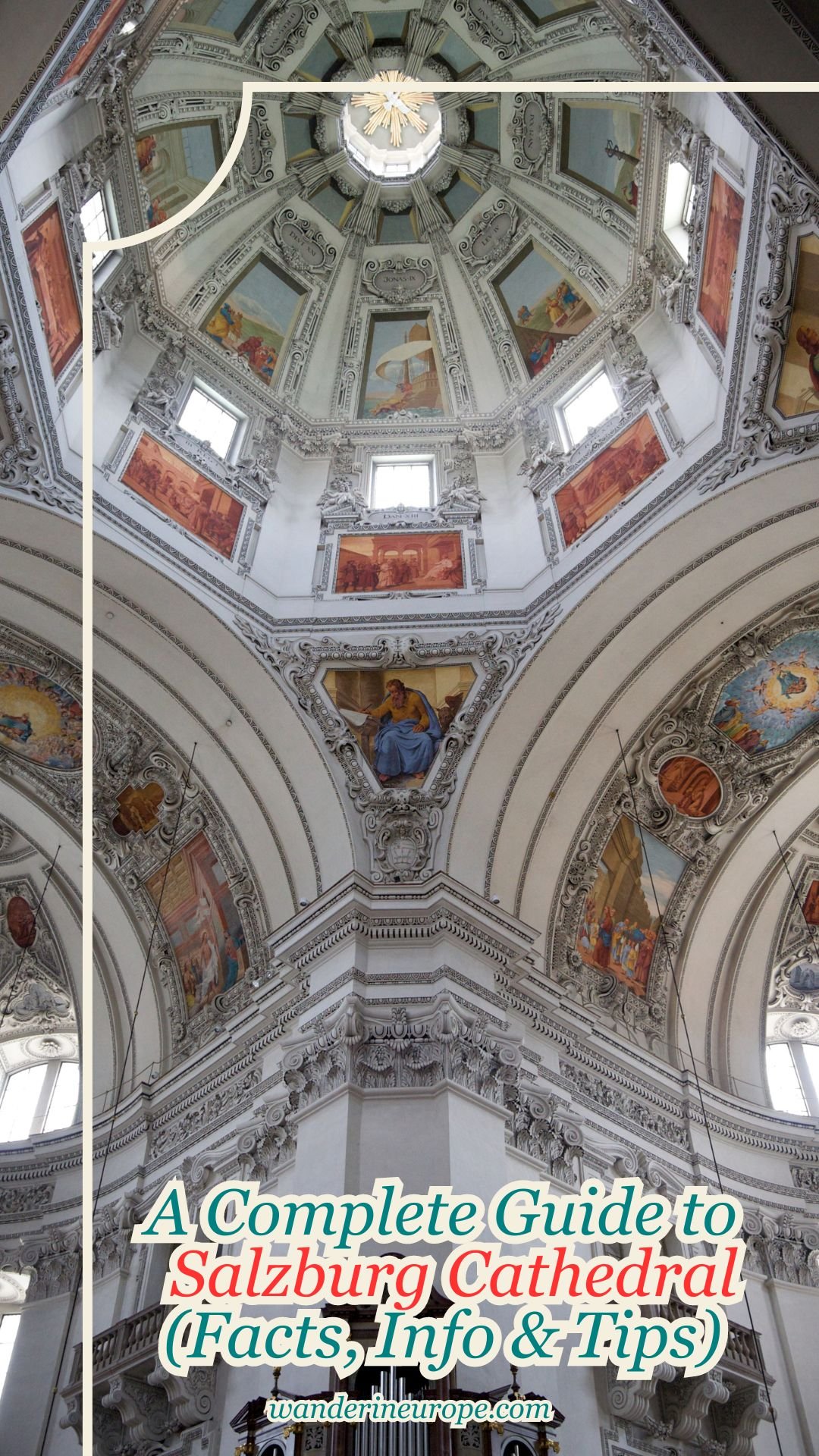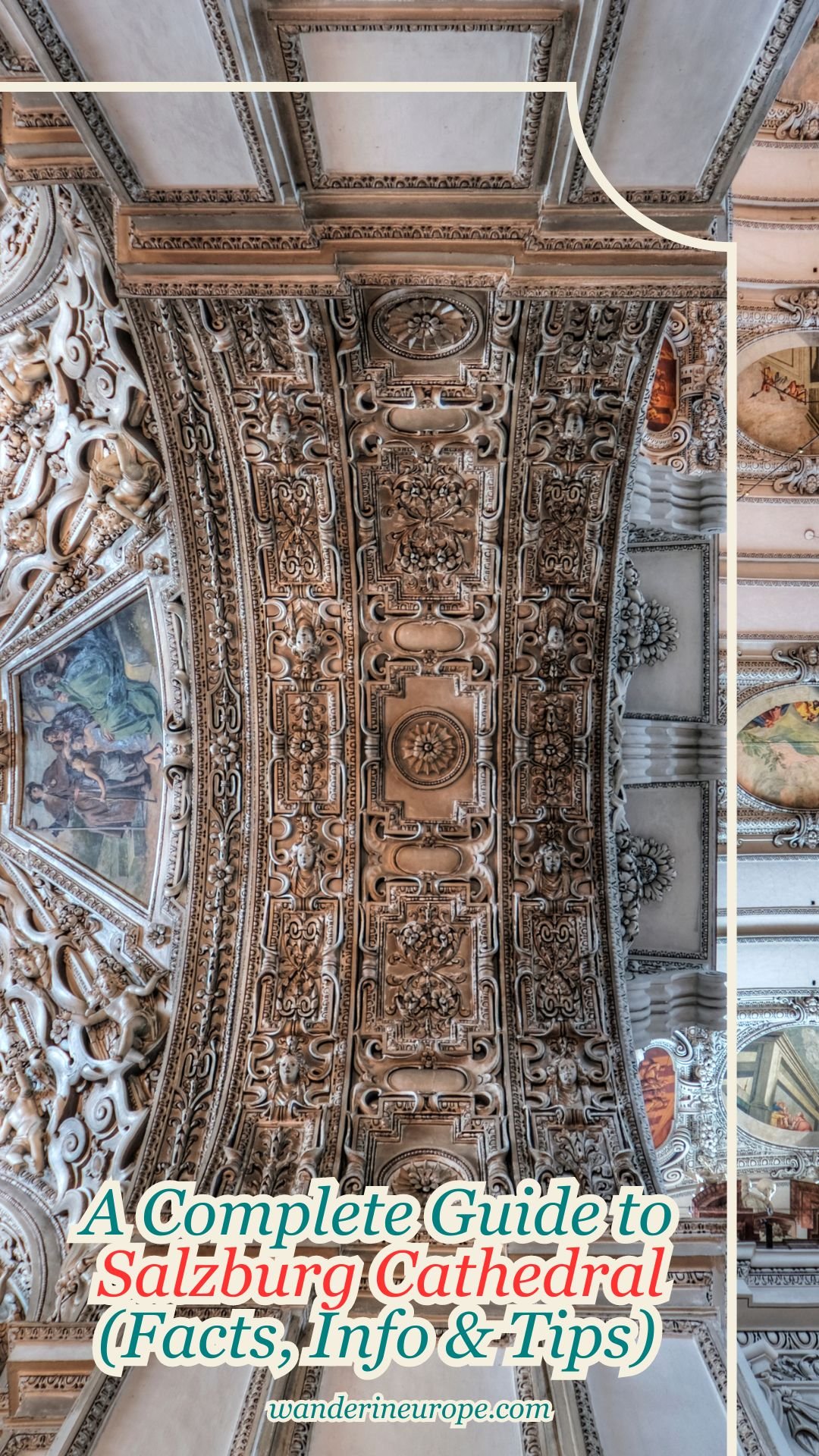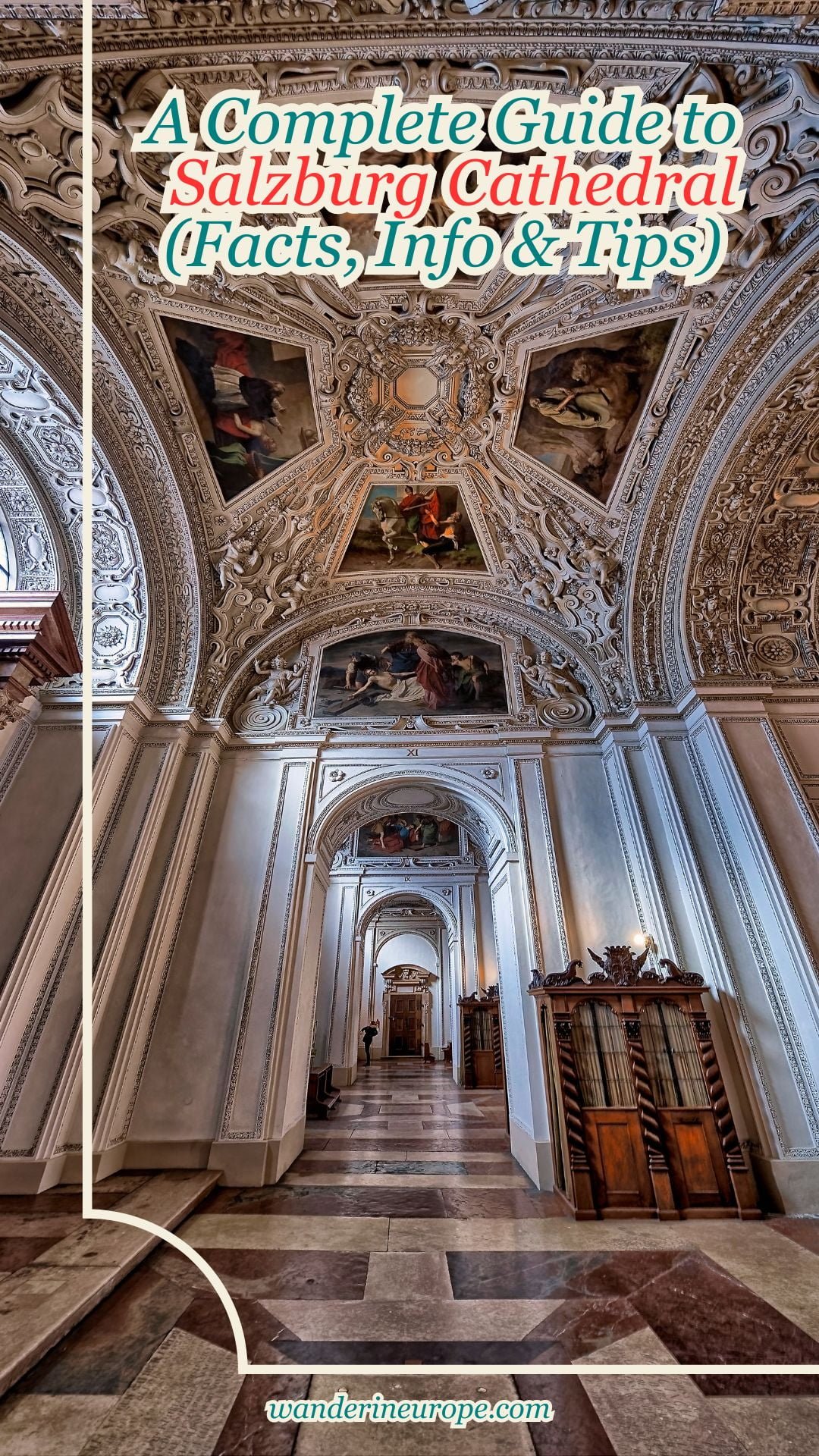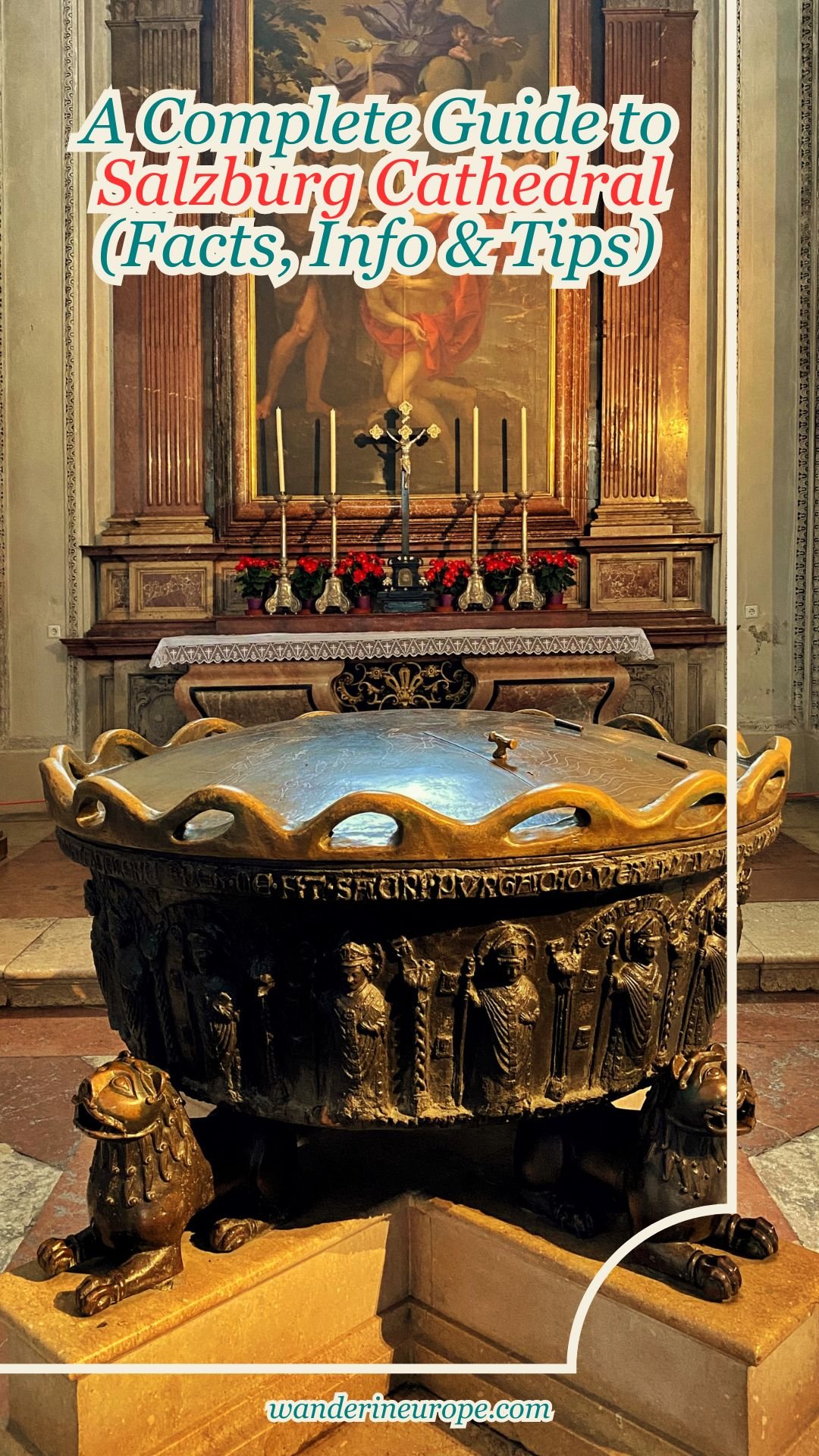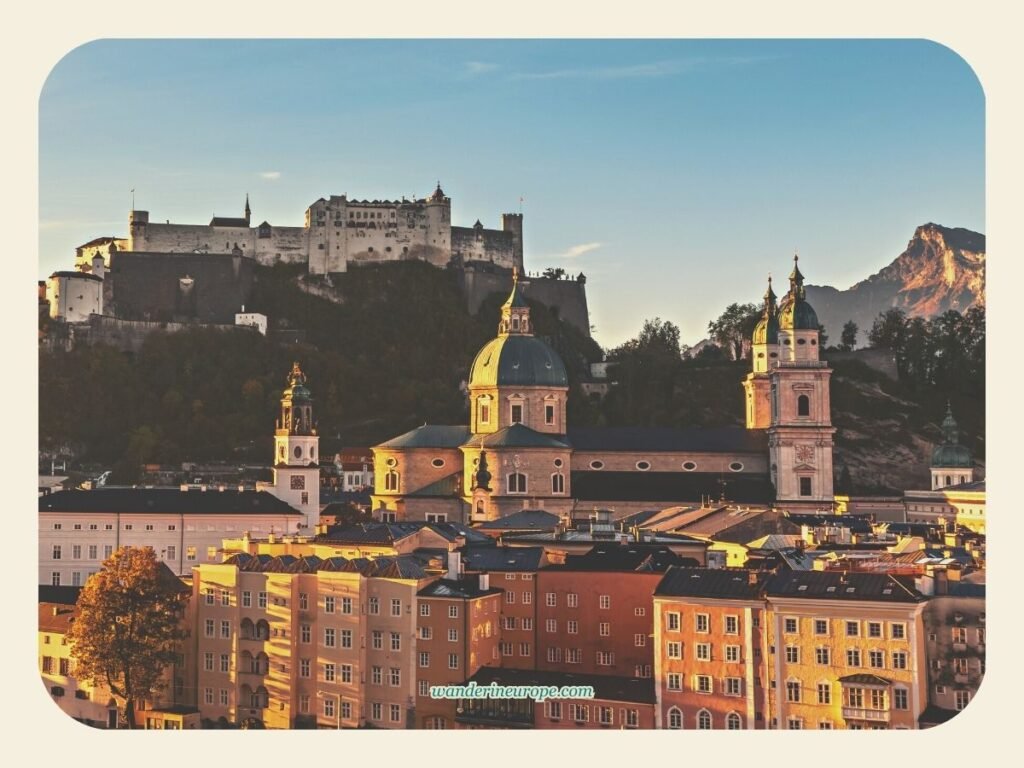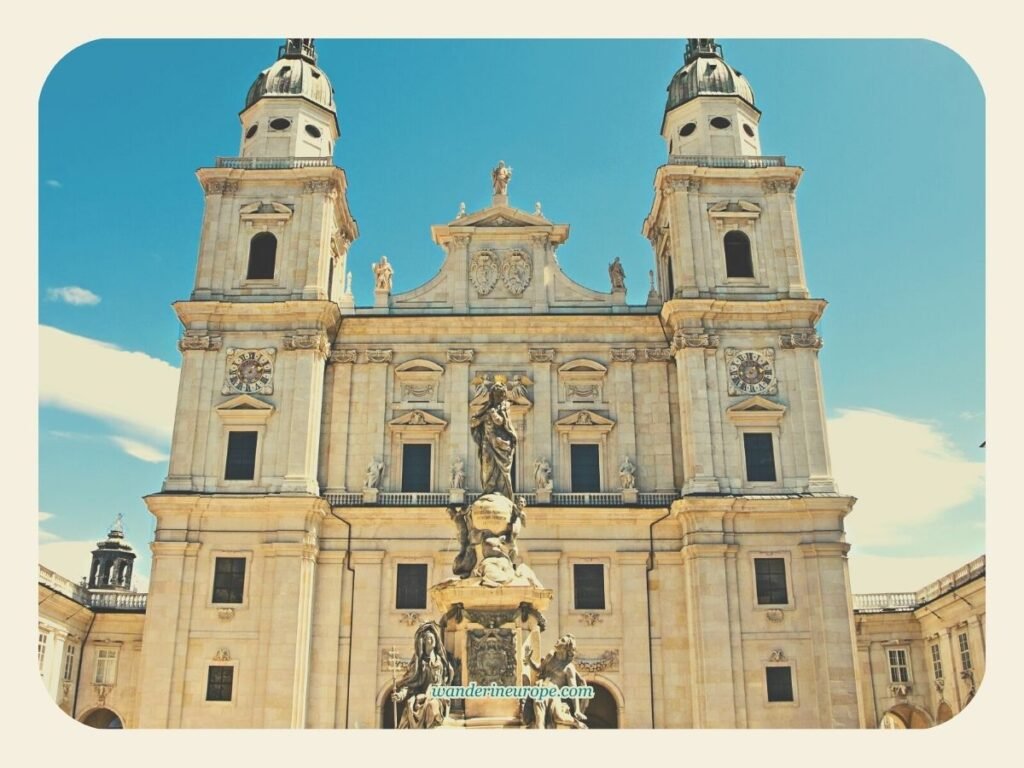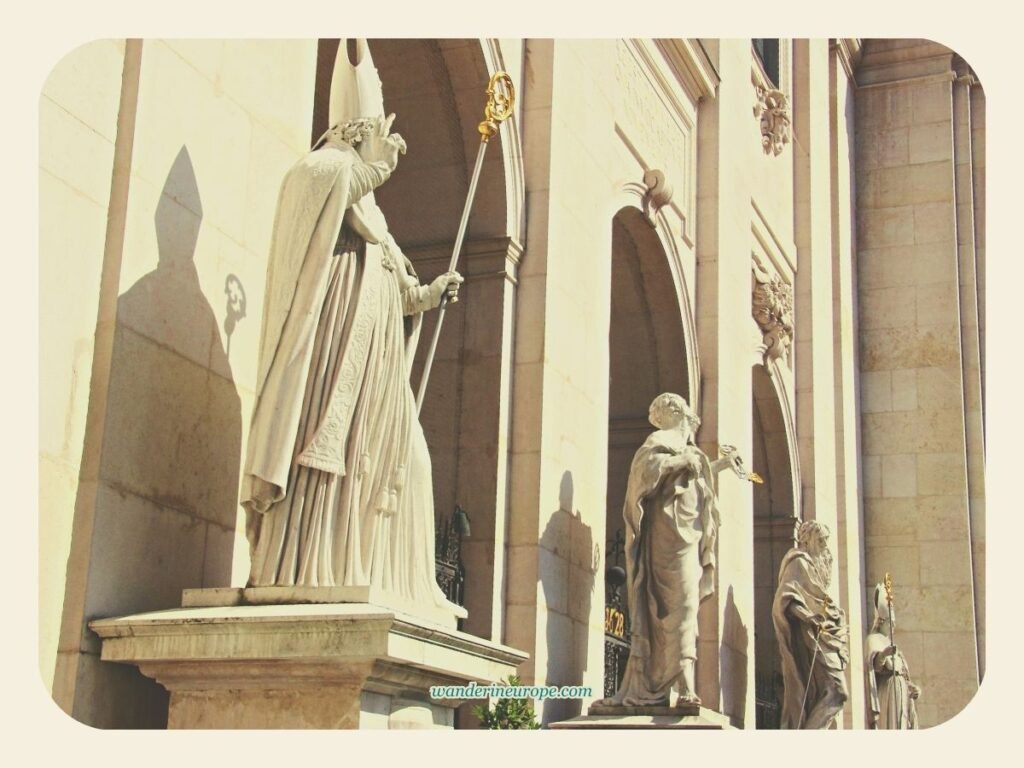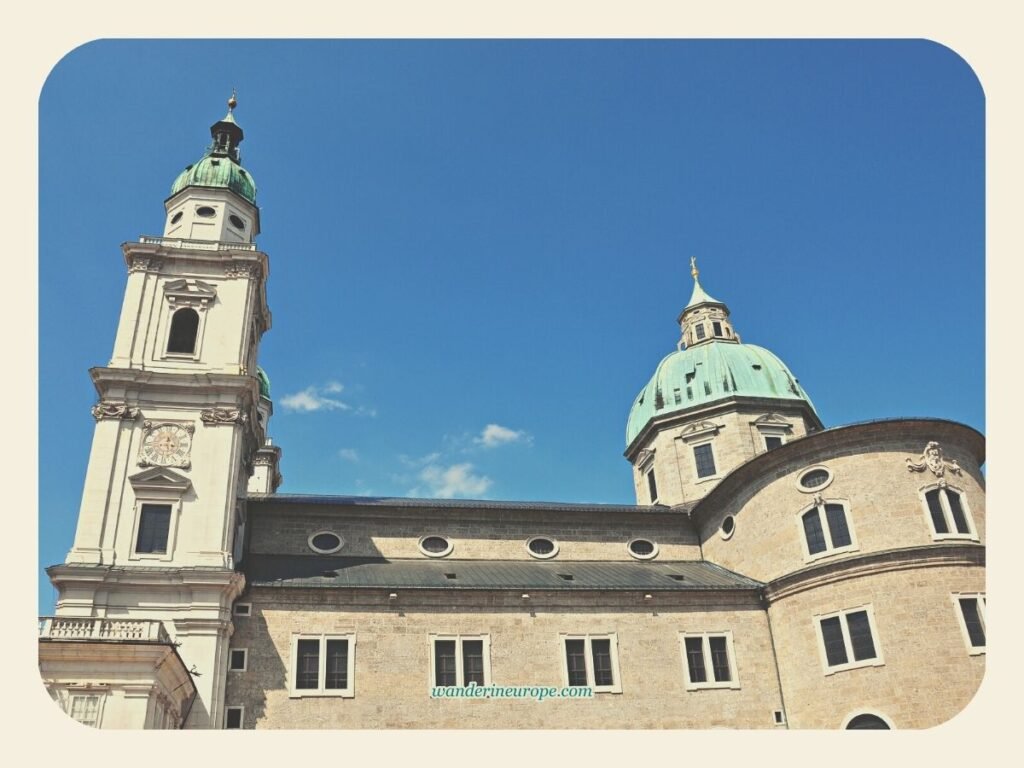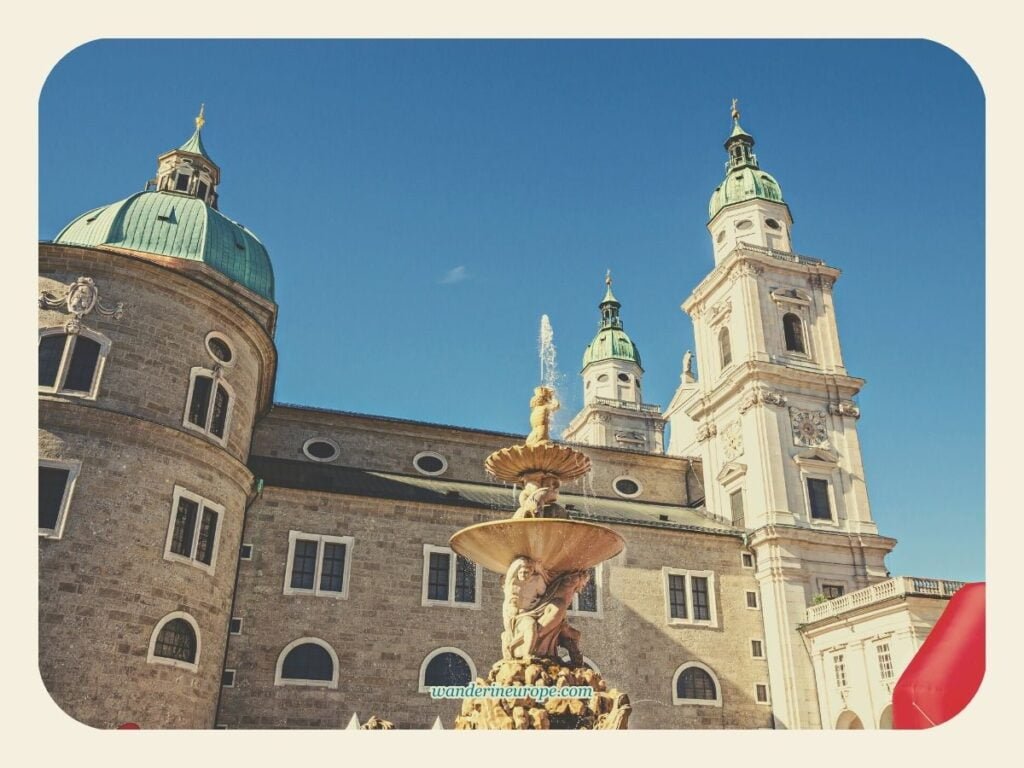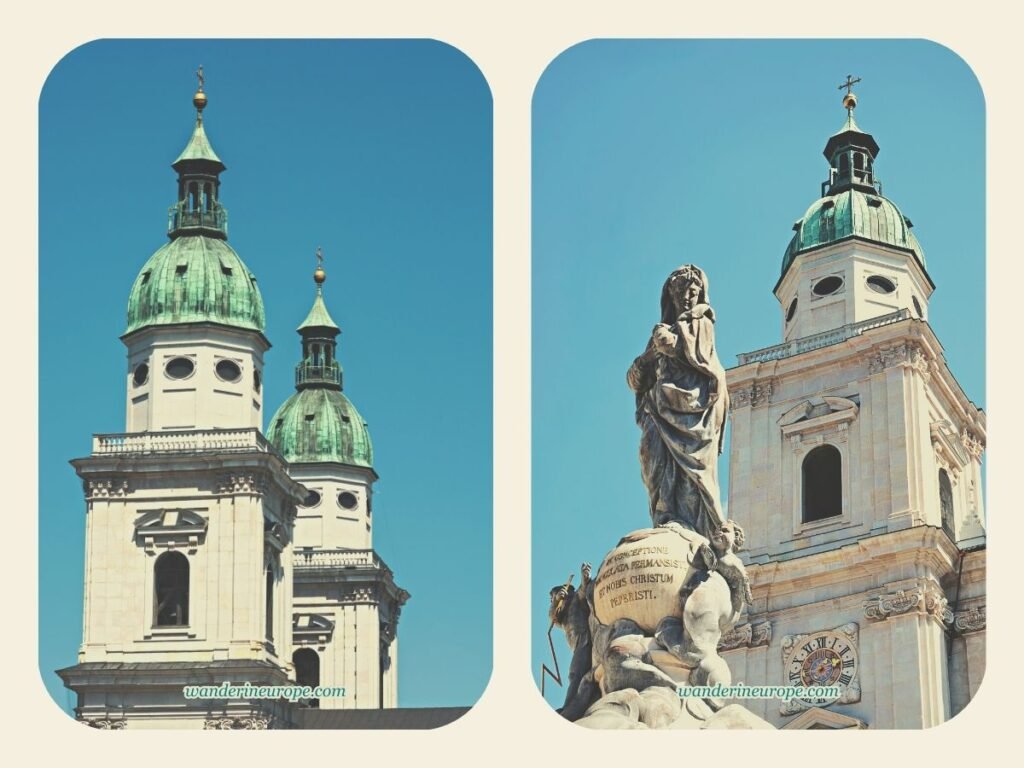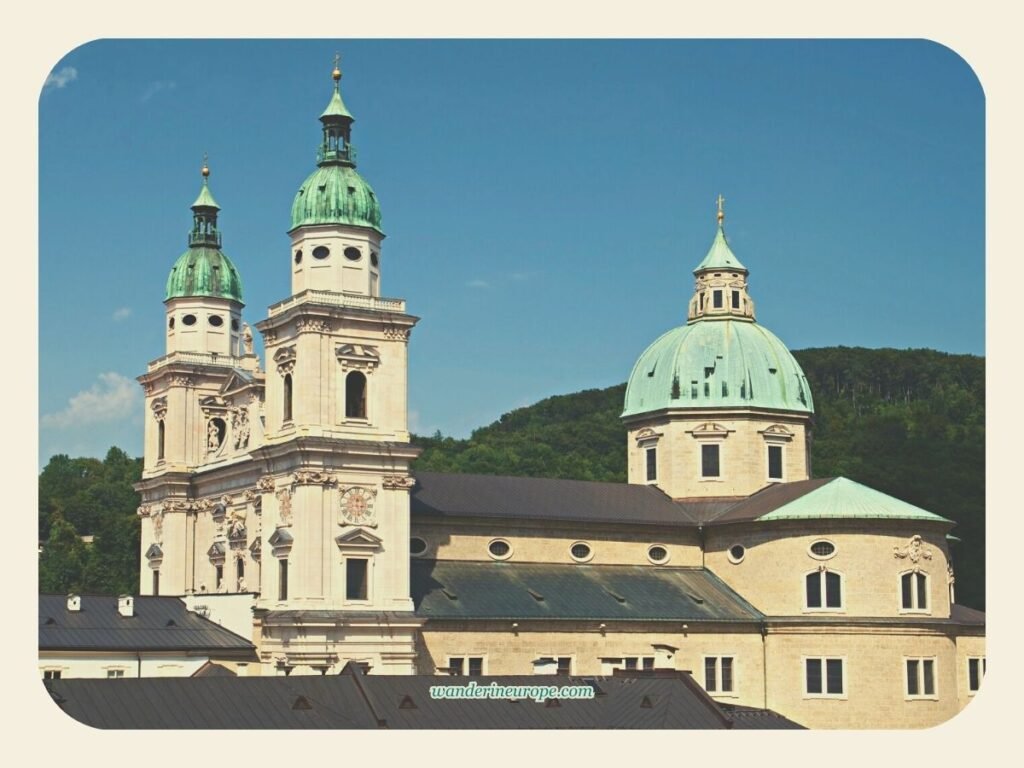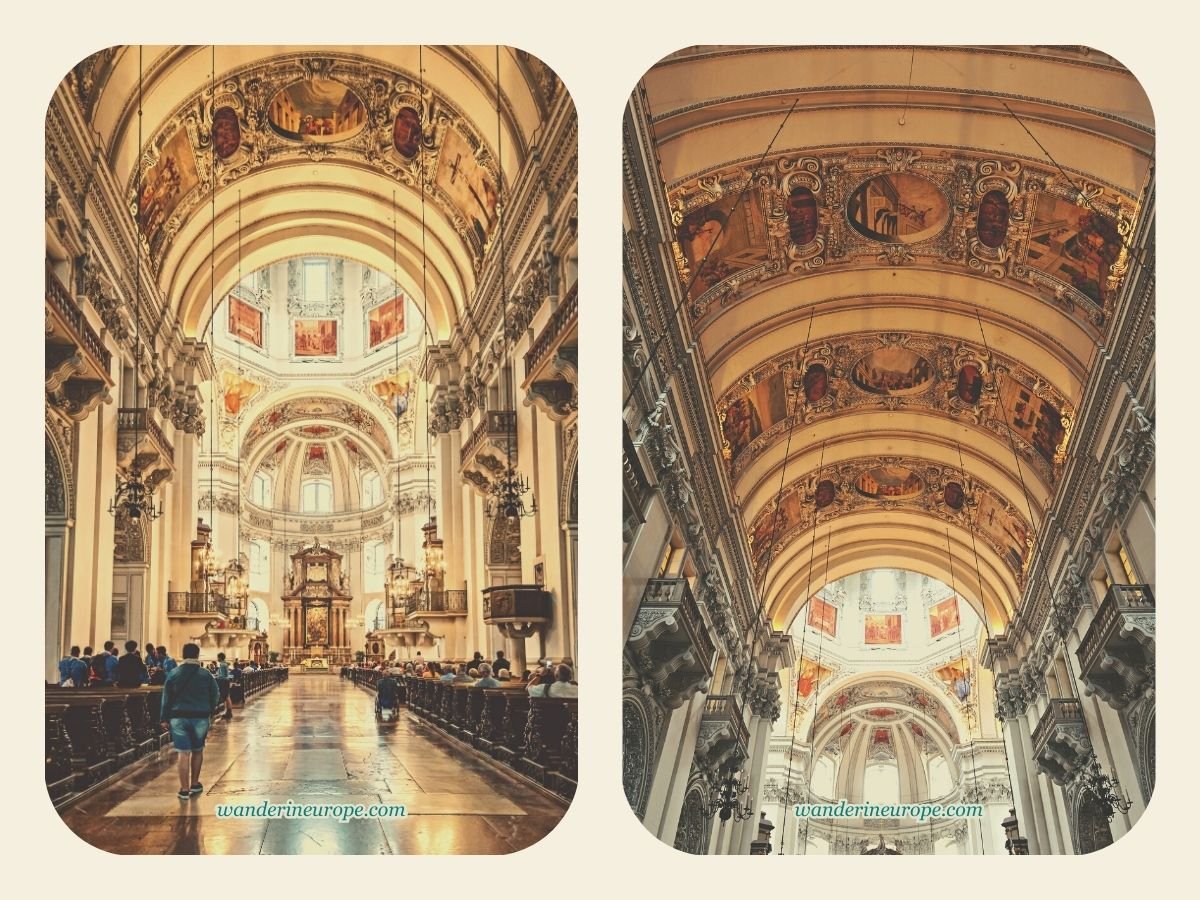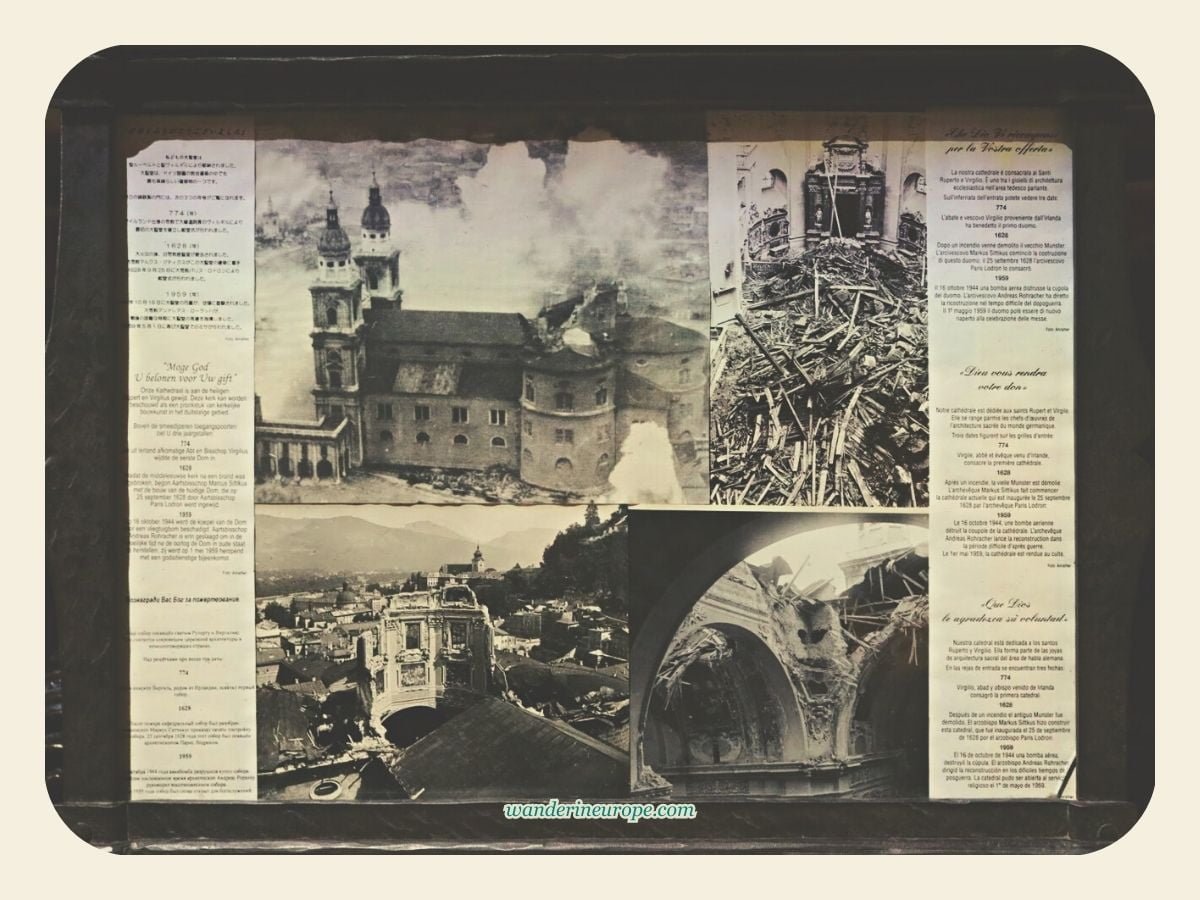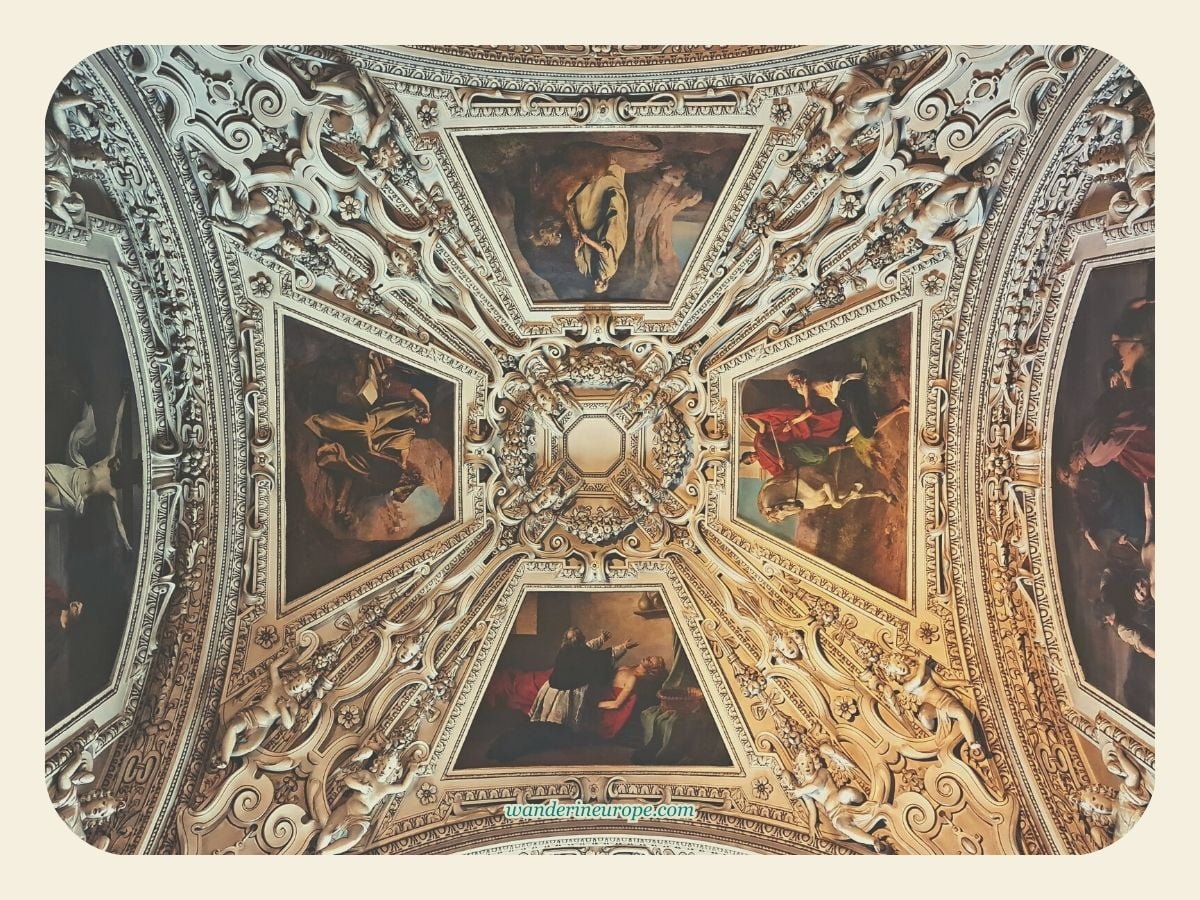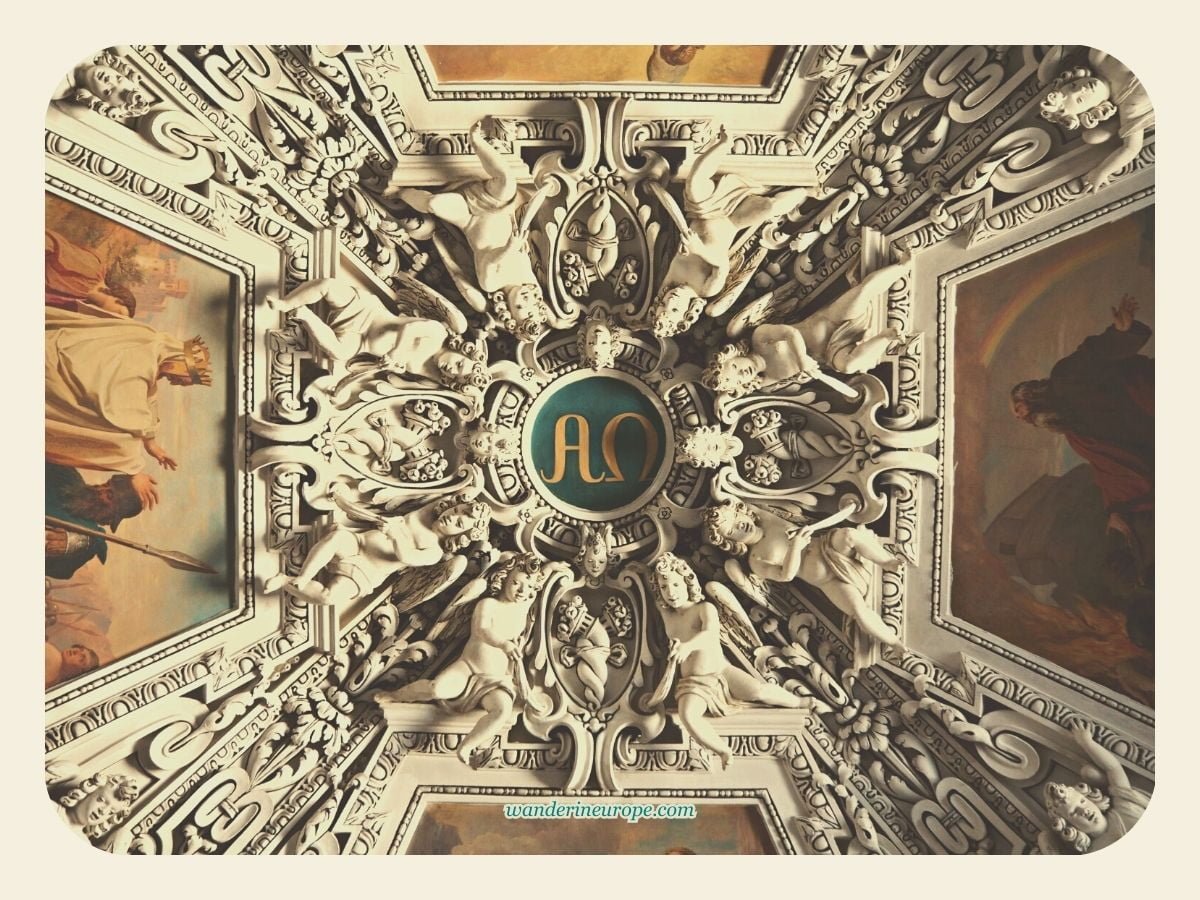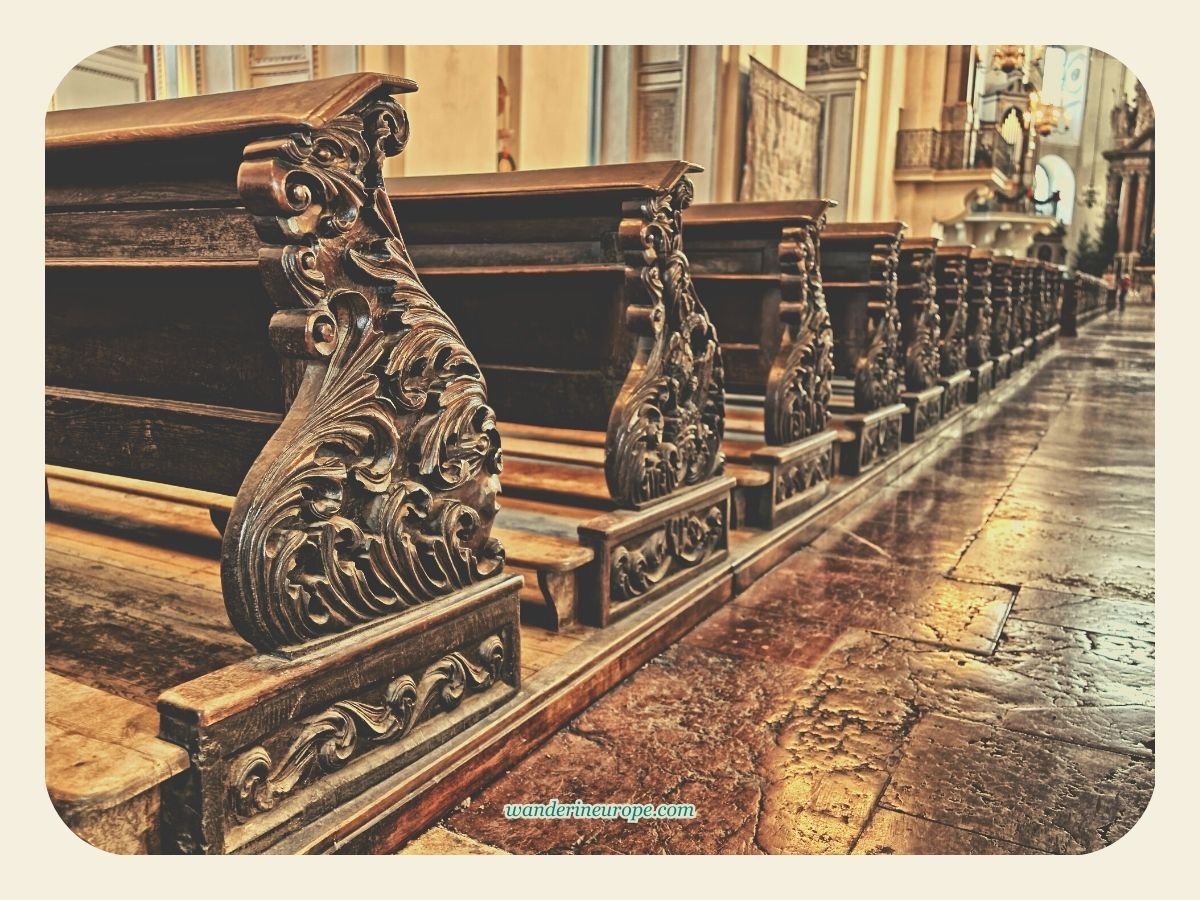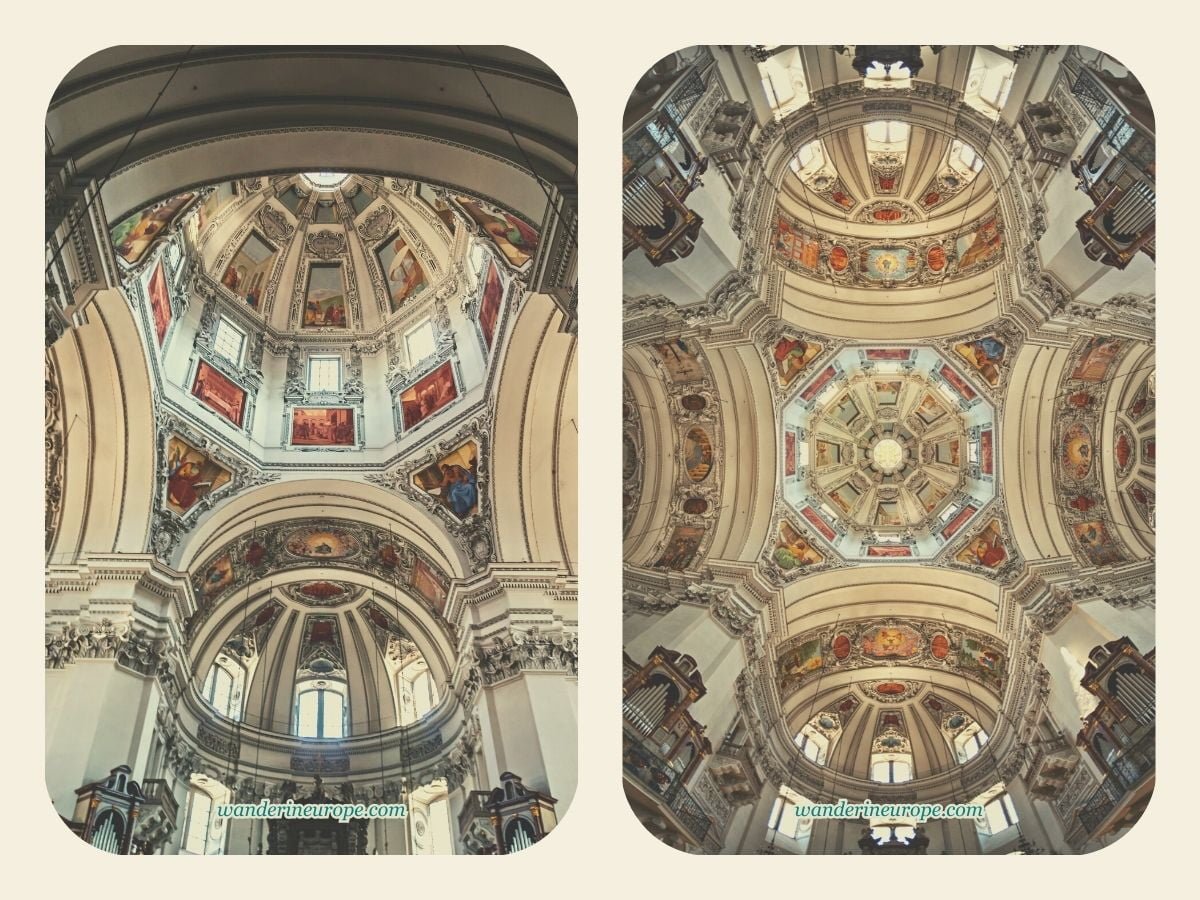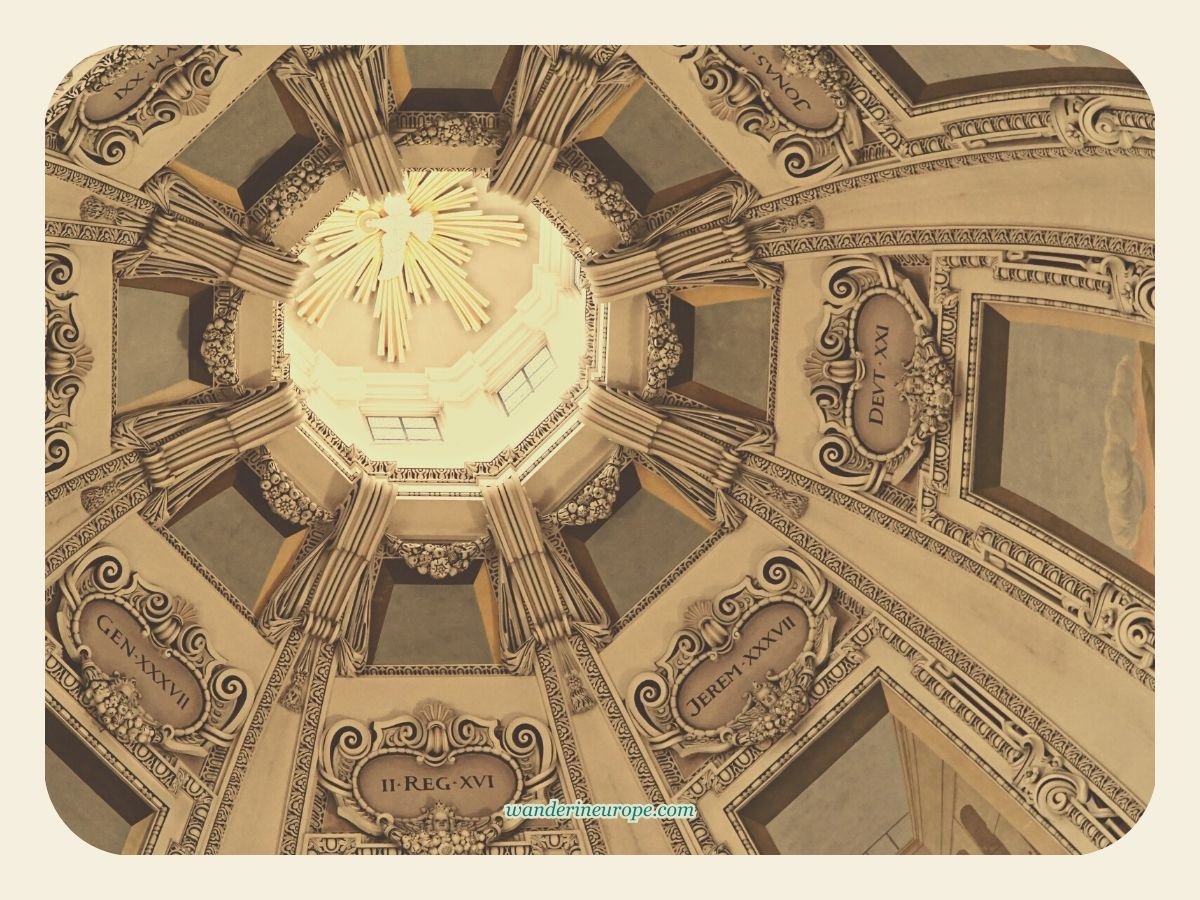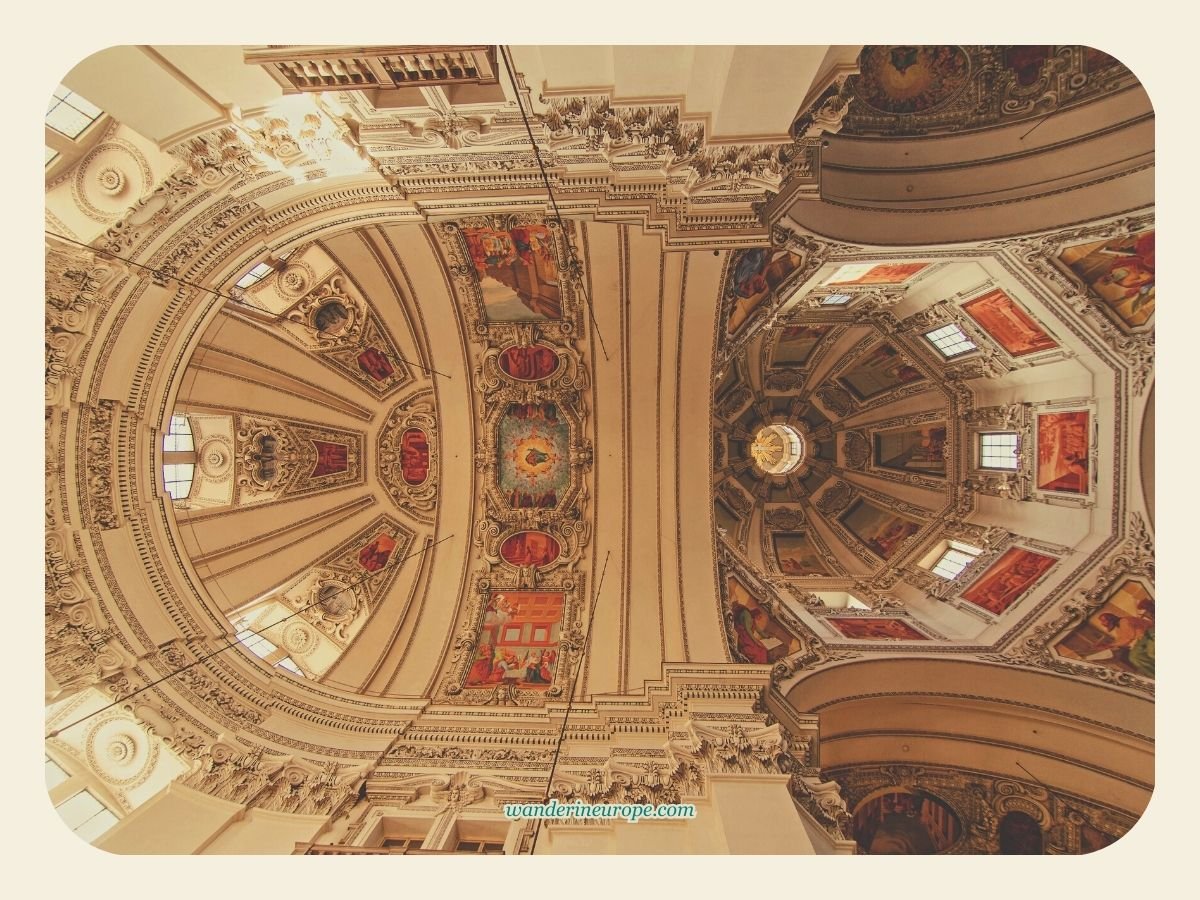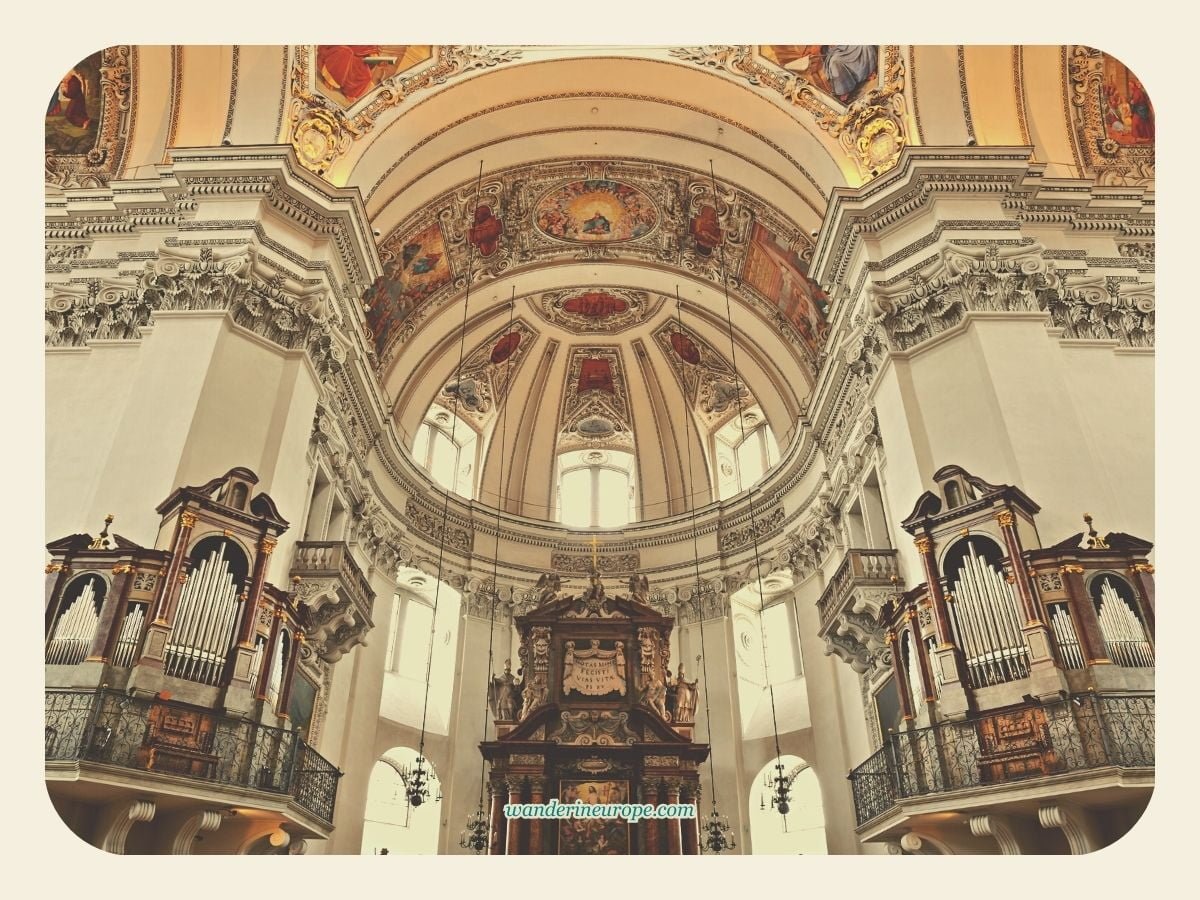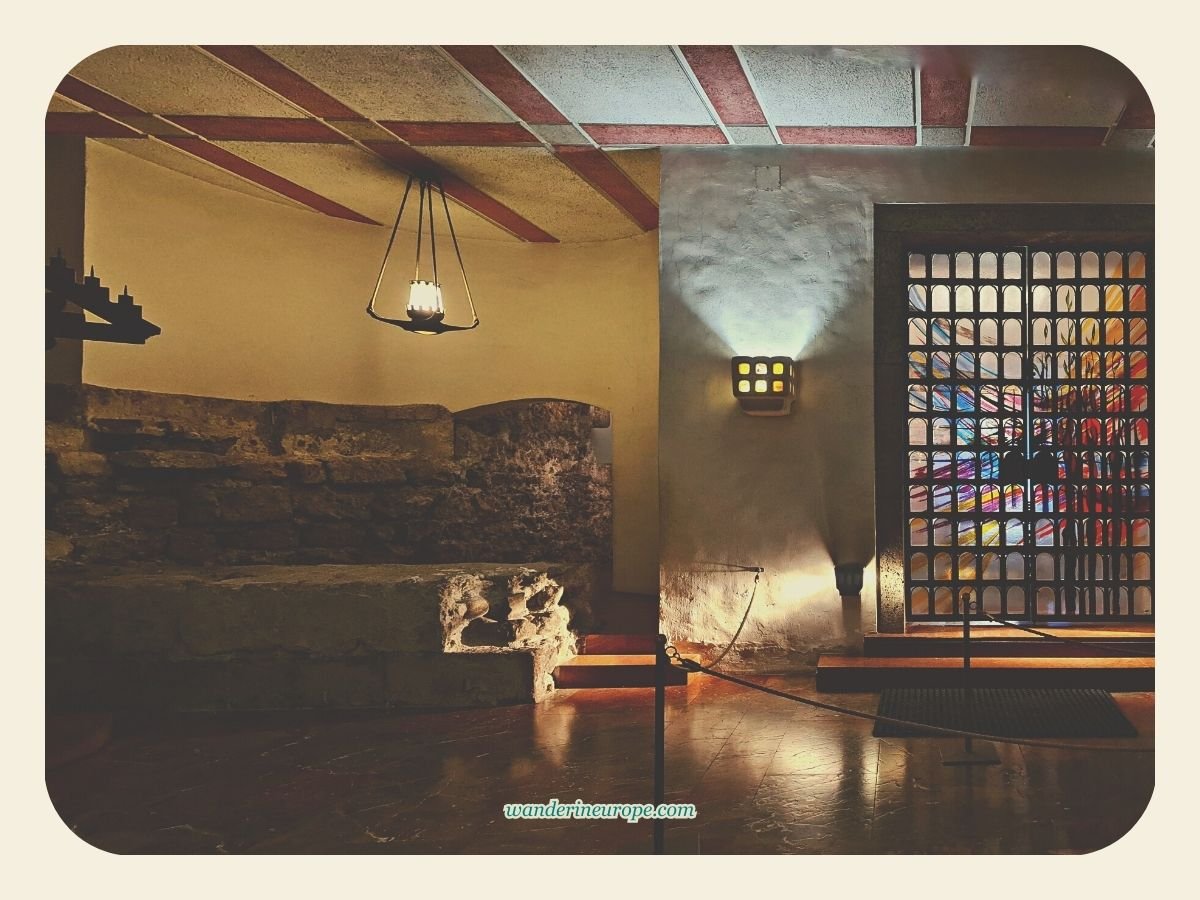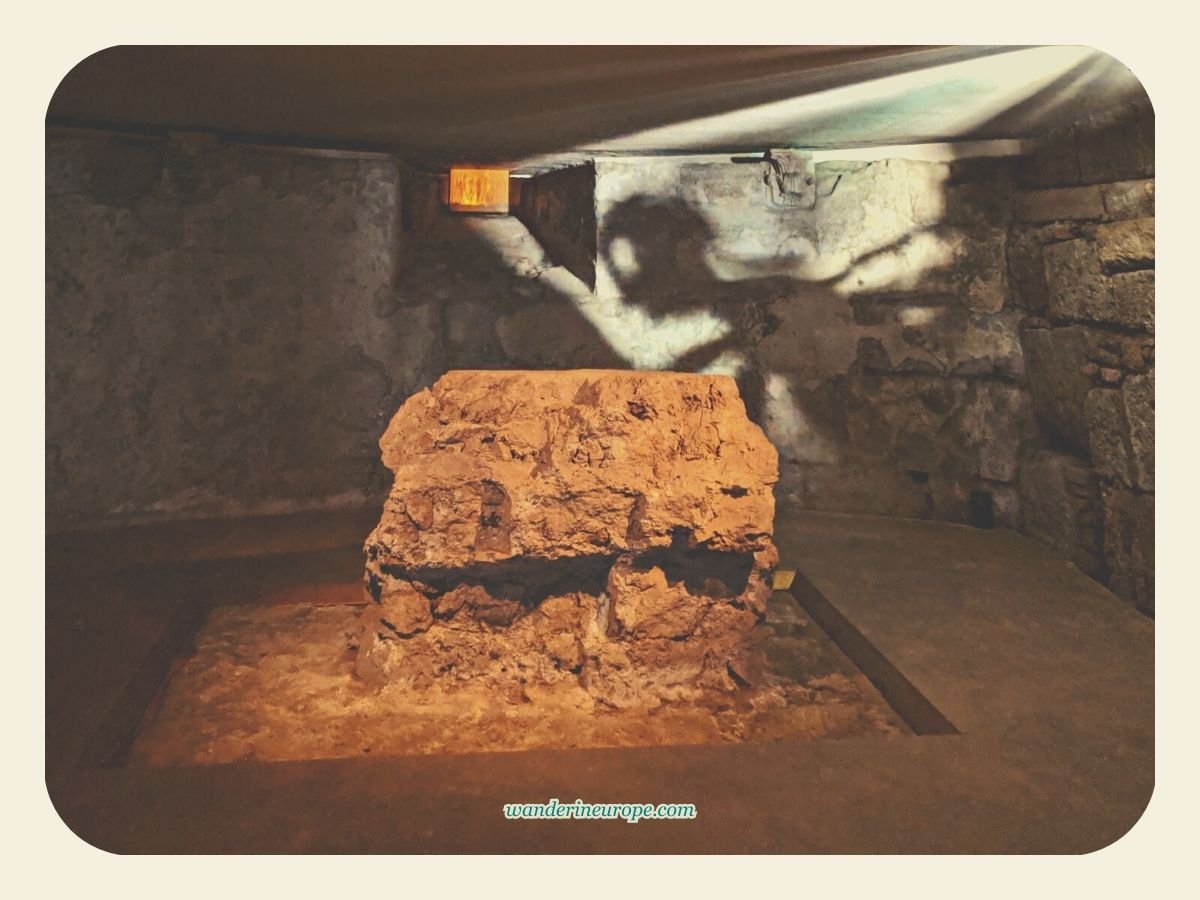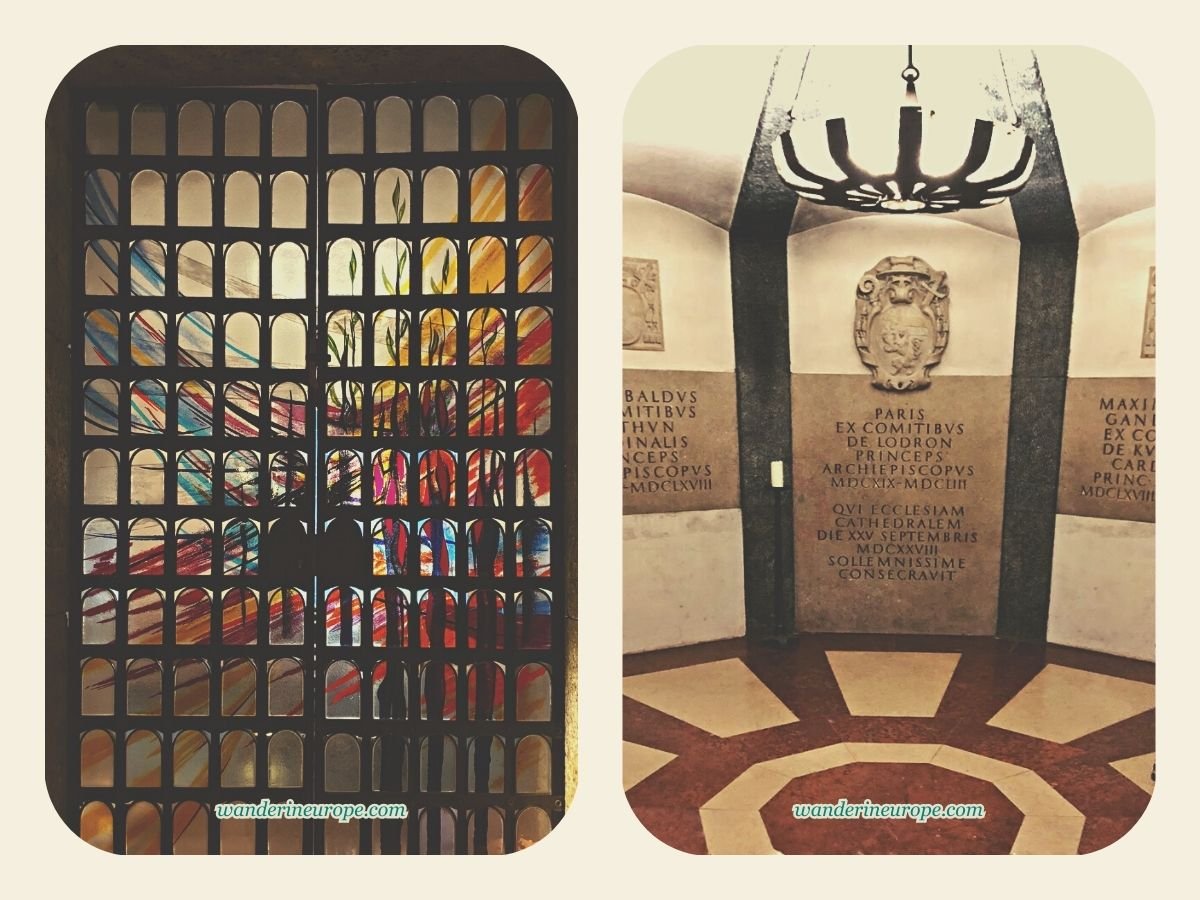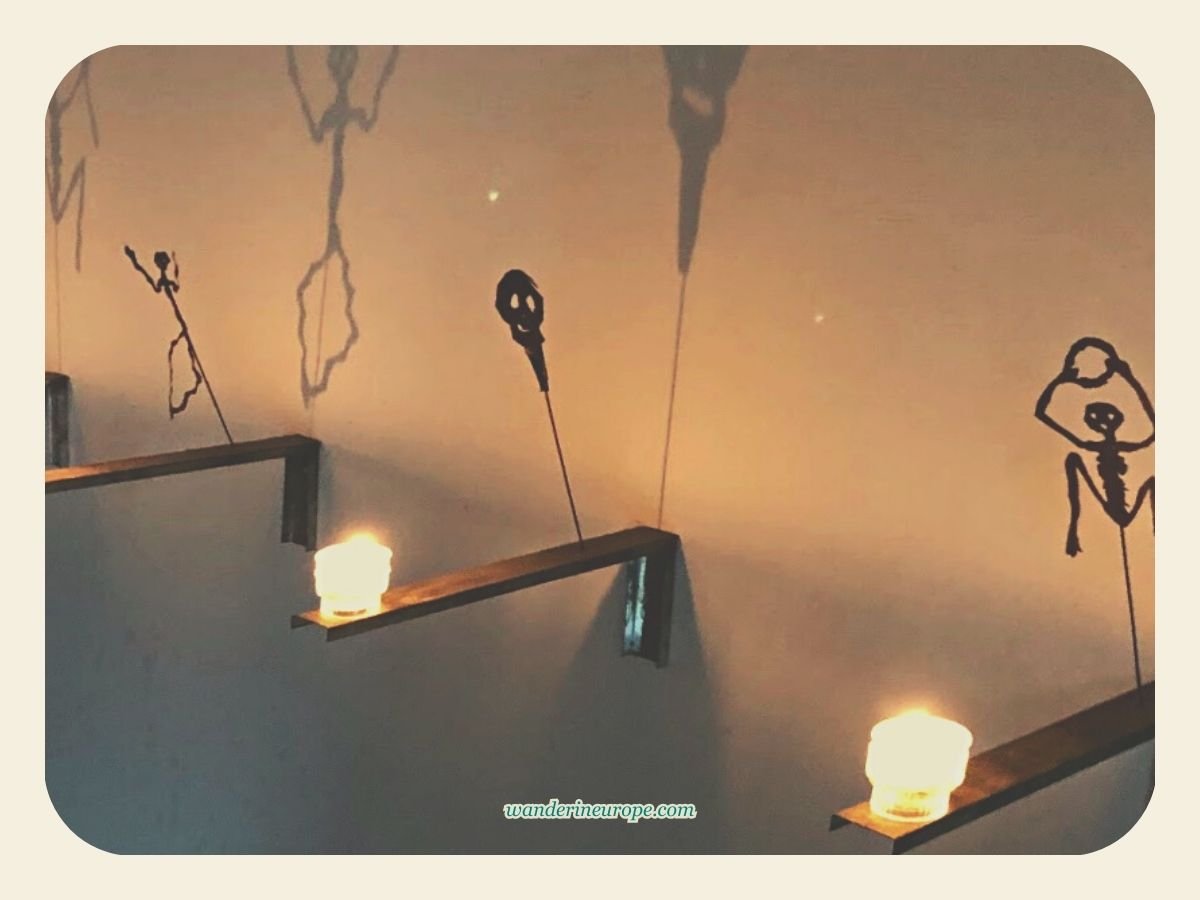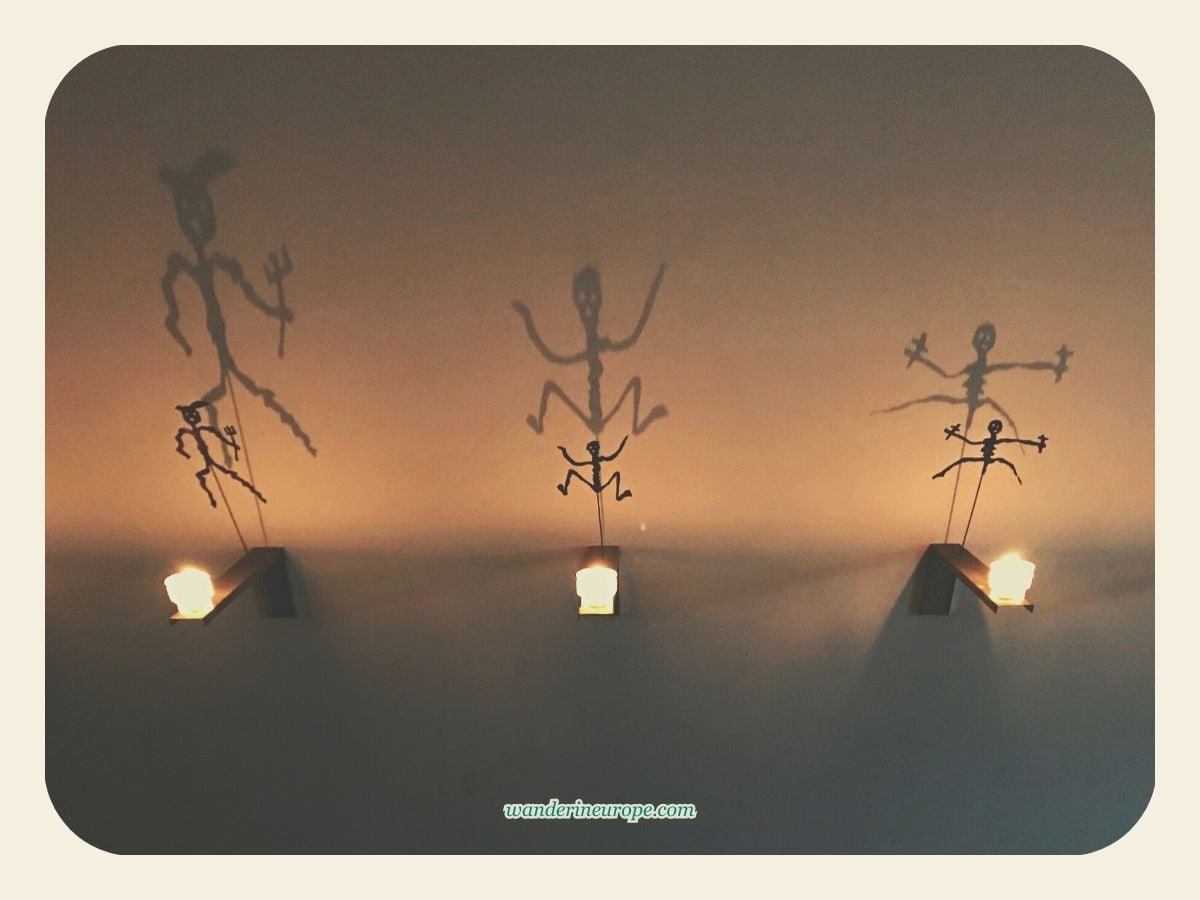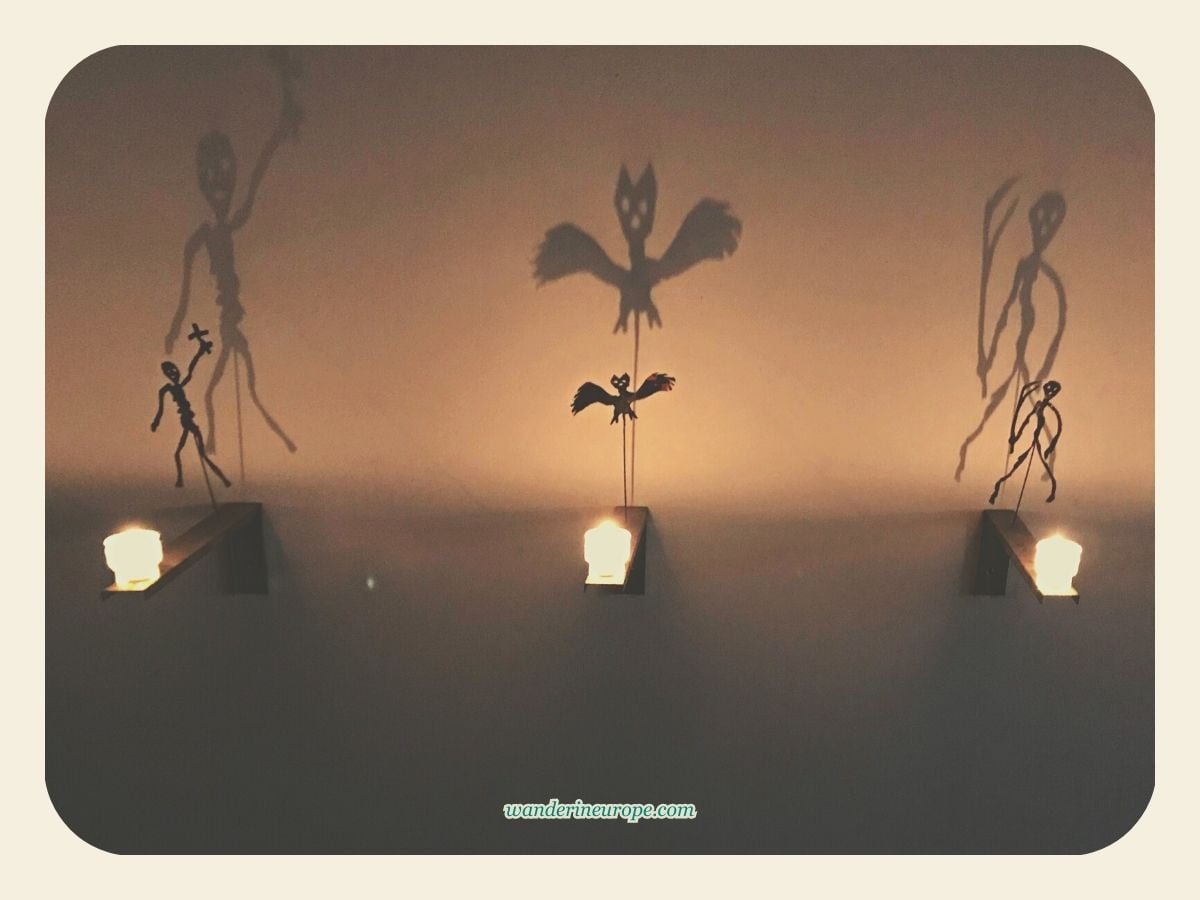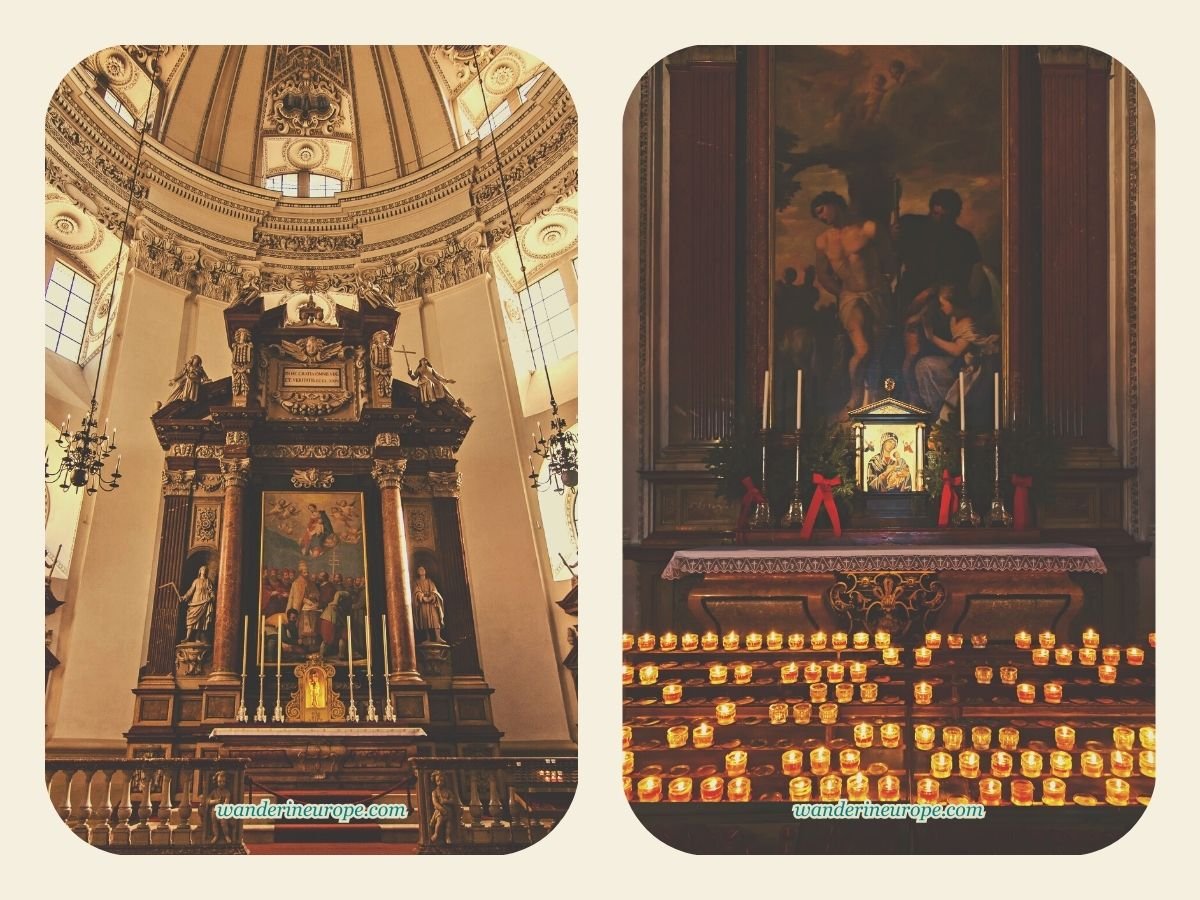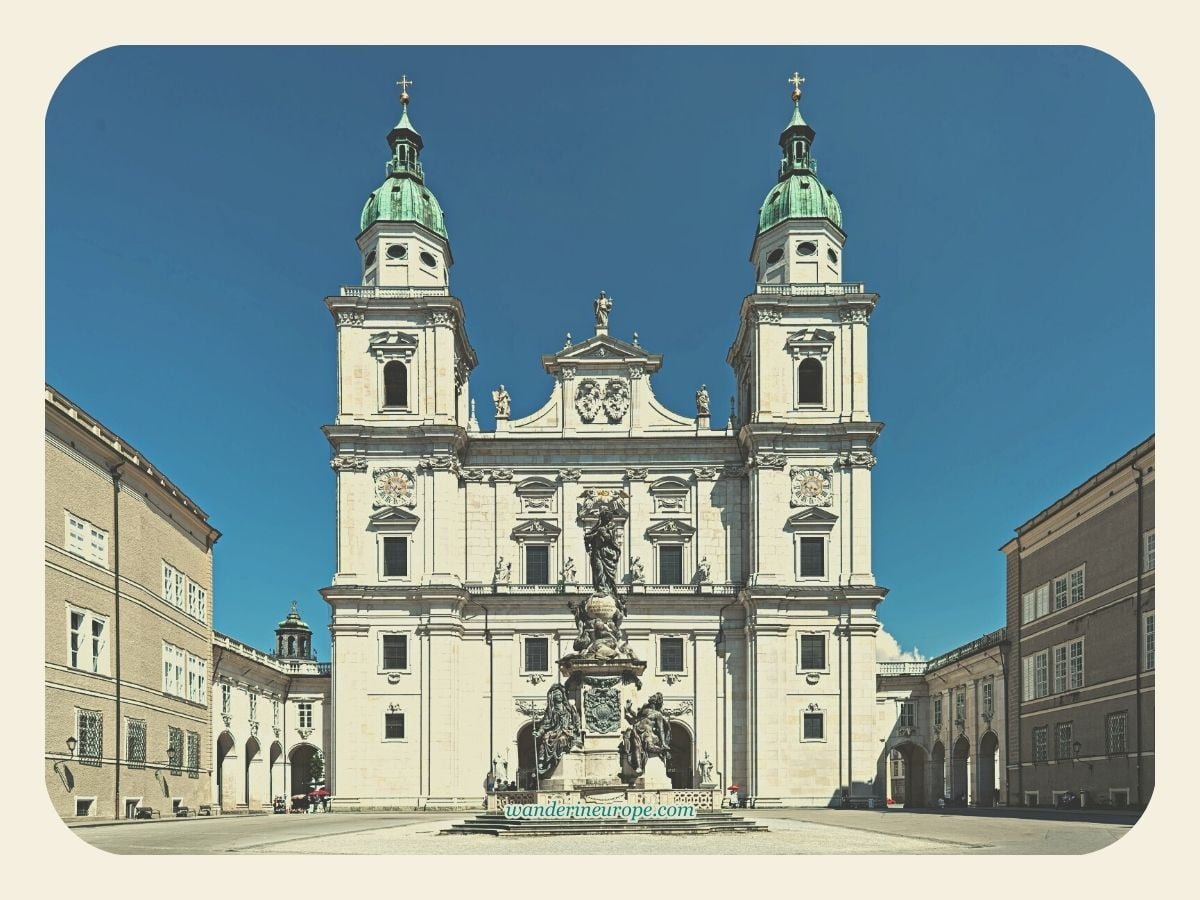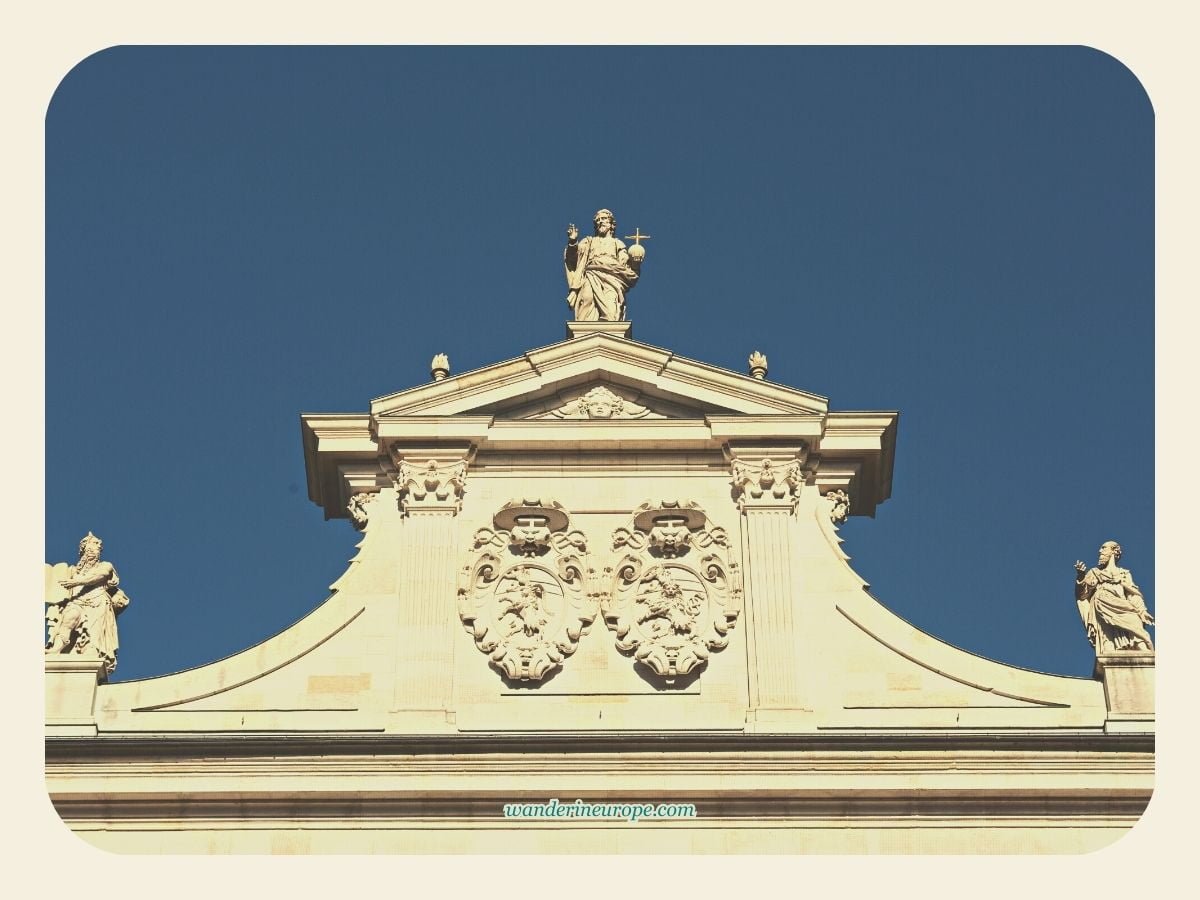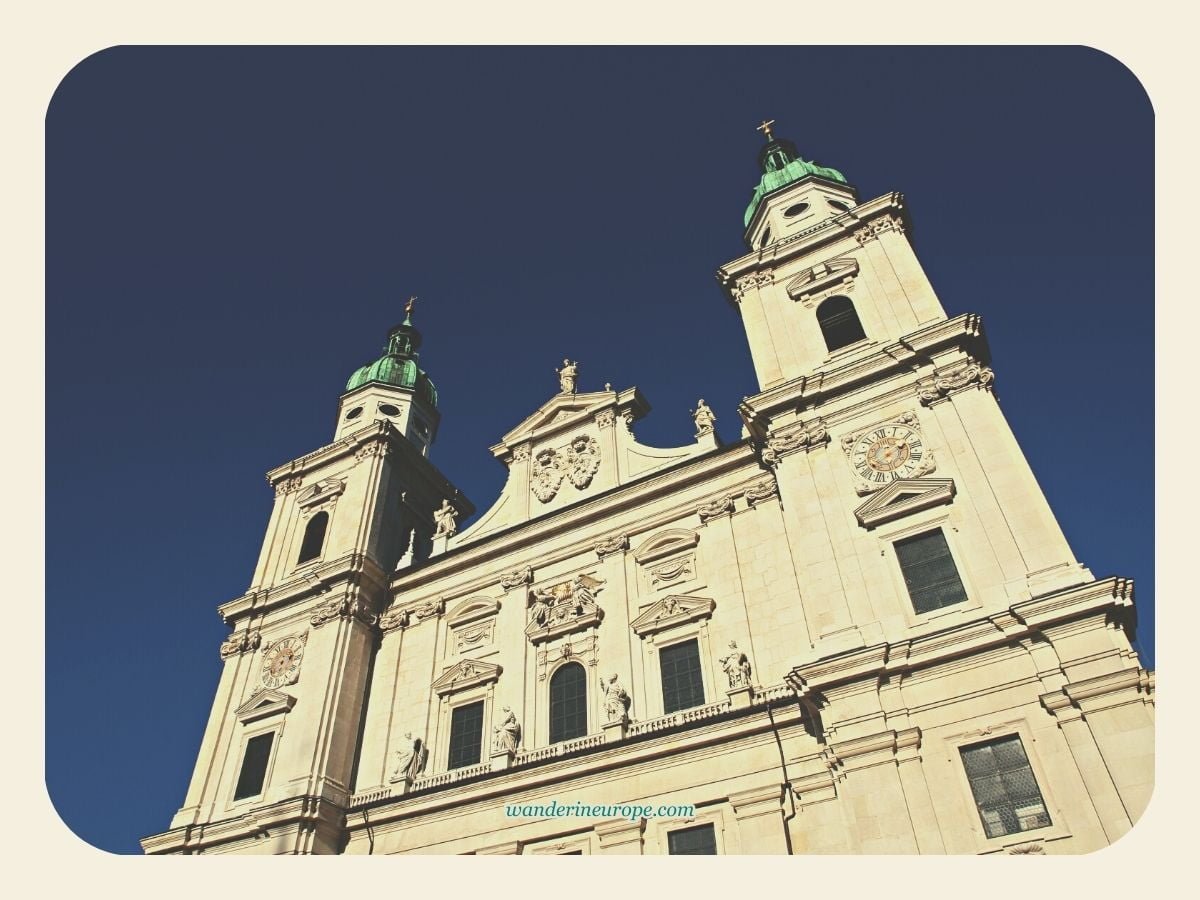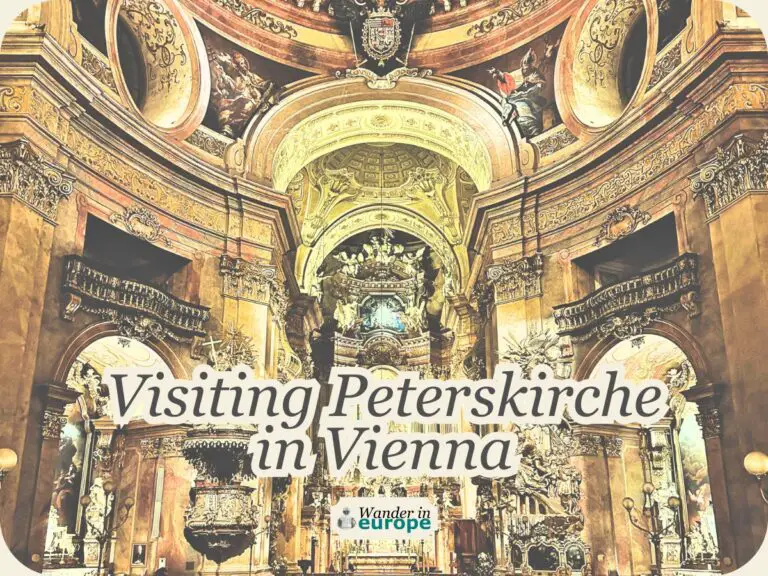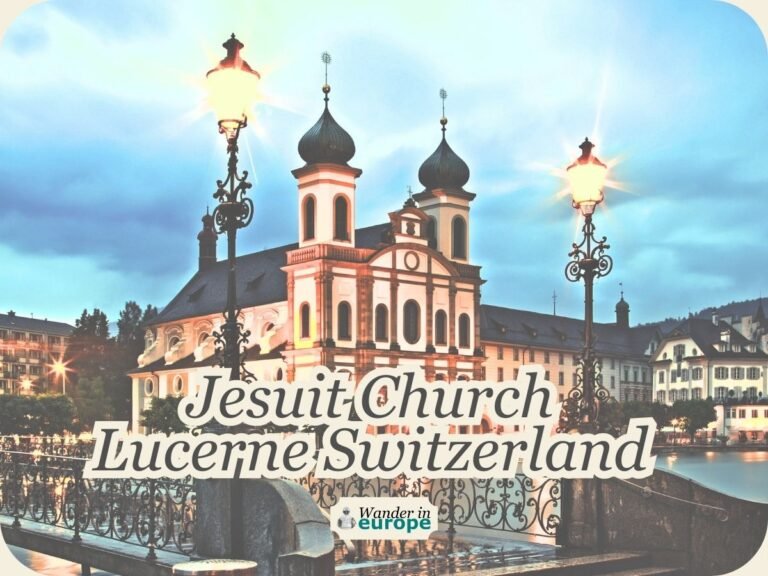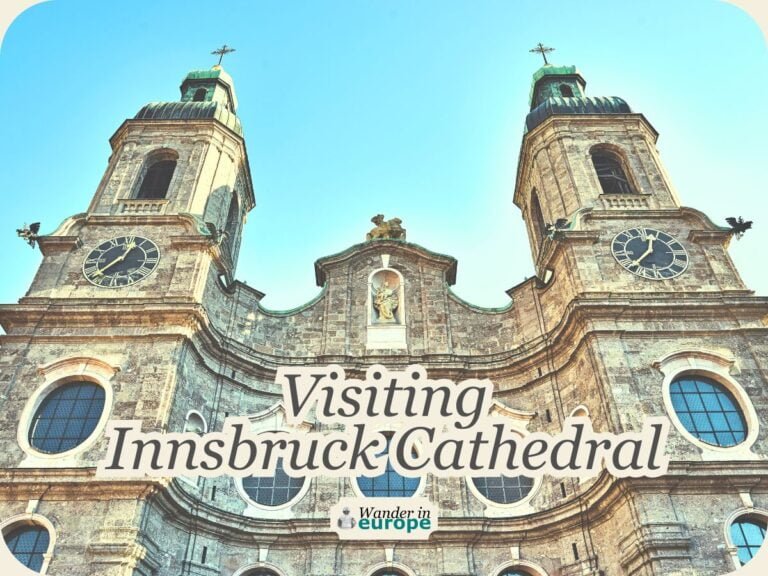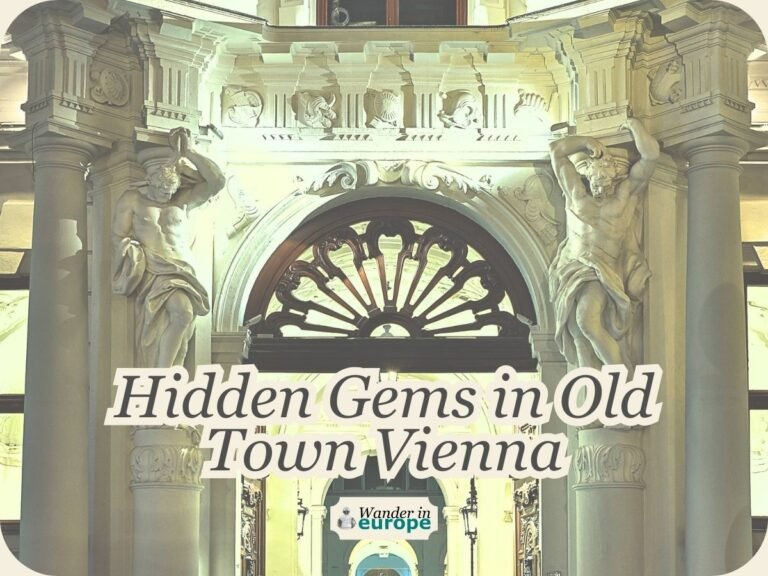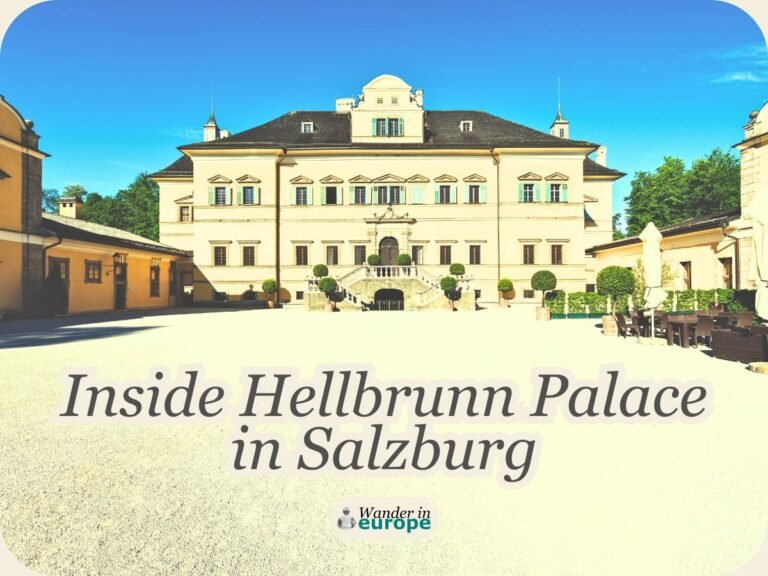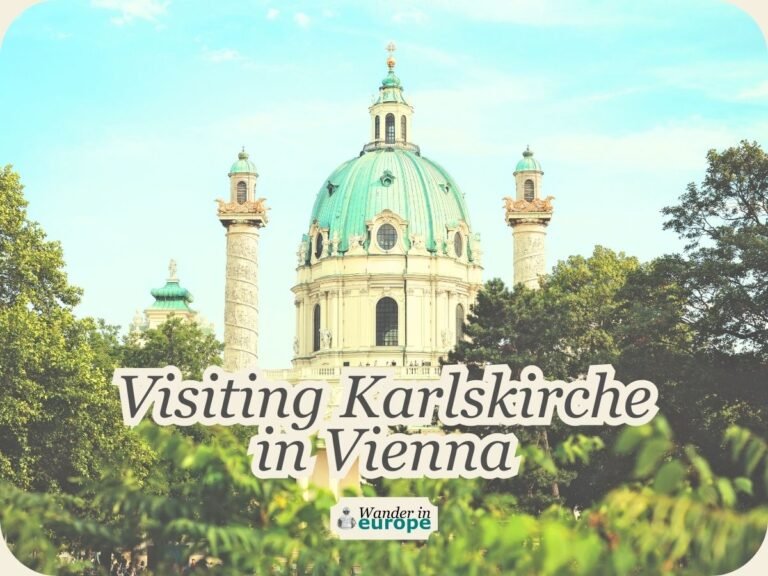A Complete Guide to Salzburg Cathedral (Facts, Info & Tips)
Notes & Disclaimer: (1) Google seems to be having a hiccup. Please use other search engines to find more guides and articles from WanderInEurope. (2) This website is reader supported. And this post might have affiliate links. This means we could earn a small commission if you make a qualifying purchase. No additional cost to you. More info: Disclosure.
The Prince-Archbishops, who ruled Salzburg for centuries, left the city with a rich, beautiful religious heritage. The city’s Baroque skyline, dominated by spires and domes of its churches, simply shows how deeply interconnected Salzburg with its religion — Christianity.
If you are a traveler wanting to discover Salzburg’s beautiful heritage, one of the best places to start is Salzburg Cathedral — the center of Christianity in the city. Salzburg Cathedral is full of meaningful Christian symbolism, breathtaking architectural features, and offers a musical experience that complements Salzburg’s musical heritage.
As a wanderer, I find Salzburg Cathedral to be one of the places that makes Salzburg a beautiful city. Alongside Hohensalzburg Fortress, Mirabell Palace, Mozart’s Birthplace, and Nonnberg Abbey, Salzburg Cathedral is one of the must-see historical landmarks and architectural attractions when exploring Old Town Salzburg. Include Salzburg Cathedral in your itinerary, whether you’re visiting Salzburg for just a day, staying for two days, or planning a 3-day getaway!
Let me give you an idea of the things that you can find and experience inside Salzburg Cathedral to help you maximize your visit to the church. Tips and visiting information are included!
Good to know
Overview
After exploring Salzburg Cathedral and listening to its audio guide (get your entry tickets & audio guide here), I can say without a doubt that Salzburg Cathedral is the most beautiful and significant church in the city. Built in the Baroque style during the 17th century, the cathedral is located in the heart of Old Town Salzburg — now a UNESCO World Heritage Site. There it stands as a symbol of God as the core of the life of the city; a reminder that God is the center of our lives as humans.
Salzburg Cathedral is dedicated to its two patron saints, who help guide the faithful closer to God. Interestingly, both saints were once residents of Salzburg and served the local community in their religious roles during their lifetimes. The first is Saint Rupert, the original bishop of Salzburg and protector of salt miners. The second is Saint Virgil, another bishop of Salzburg who helped spread Christianity to the Alpine Slavs.

History
A destination’s history can often make it more interesting to visit. By understanding its past, you can gain a deeper appreciation for the age and significance of the place you’re exploring.
The history of Salzburg Cathedral dates back to the 8th century when Saint Vergilius of Salzburg constructed the first cathedral between 767 and 774. At the time Salzburg Cathedral was known as the Virgil Dom and was quite an impressive structure, measuring 66 meters in length and 33 meters in width. In 842, the building was unfortunately struck by lightning and burned down. However, the people of Salzburg didn’t give up. Just three years later, they began rebuilding the structure.
Over the next few centuries, the cathedral underwent several more building and rebuilding campaigns. For example, between 1000 and 1080, Archbishop Hartwig added a choir and crypt to the west side of the sanctuary. And between 1106 and 1147, Archbishop Konrad I added the west towers. But in 1598, disaster struck again when the basilica was severely damaged.
Despite several attempts at restoration and reconstruction, Prince-Bishop Wolf Dietrich Raitenau, the current ruler of Salzburg that time, eventually ordered it to be demolished. Wolf Dietrich was a patron and supporter of modern Italian Baroque architecture, and he wanted to build something new and grand in its place. While Wolf Dietrich wanted to build the cathedral in his preference, the Salzburg Cathedral we see today is the result of the vision of his cousin and successor, Markus Sittikus von Hohenems.
In 1614, Markus Sittikus planned to lay the cornerstone of a new cathedral with the help of Italian architect Vincenzo Scamozzi. However, it was ultimately another architect, Santino Solari, who brought the cathedral to what it looks like today. He dramatically altered Scamozzi’s original plans.
In less than 15 years, the new cathedral was completed and on September 24th, 1628, the church was consecrated once again. That’s why you’ll see that the present Salzburg Cathedral is partially built upon the foundations of the old basilica. In fact, you can see the foundation stones of the preceding church building in the Domgrabungen, an excavation site under the cathedral. One other surviving relic that predates the baroque edifice is a beautiful 14th century Gothic baptismal font.
Although the cathedral is a religious structure and didn’t have any military purpose, it wasn’t immune to war. In 1944, during World War II, a single bomb crashed through the central dome over the crossing. Archbishop Dr. Andreas Rohracher, the head of the Archdiocese of Salzburg that time, worked tirelessly to reconstruct the cathedral after this devastating event. Finally, in May 1959, it was reopened in all its baroque beauty that you can see today.

A glimpse to Salzburg Cathedral
Inside the Cathedral
Beautiful and intriguing things you can see inside the Cathedral
While Salzburg Cathedral may look slightly modest from the outside, its interior is one of the most graceful among the landmarks in the city. The ceiling of Salzburg Cathedral, richly adorned with frescoes and innumerable stucco works, is stunningly breathtaking. It was the first thing I noticed immediately after viewing the cathedral’s interiors.

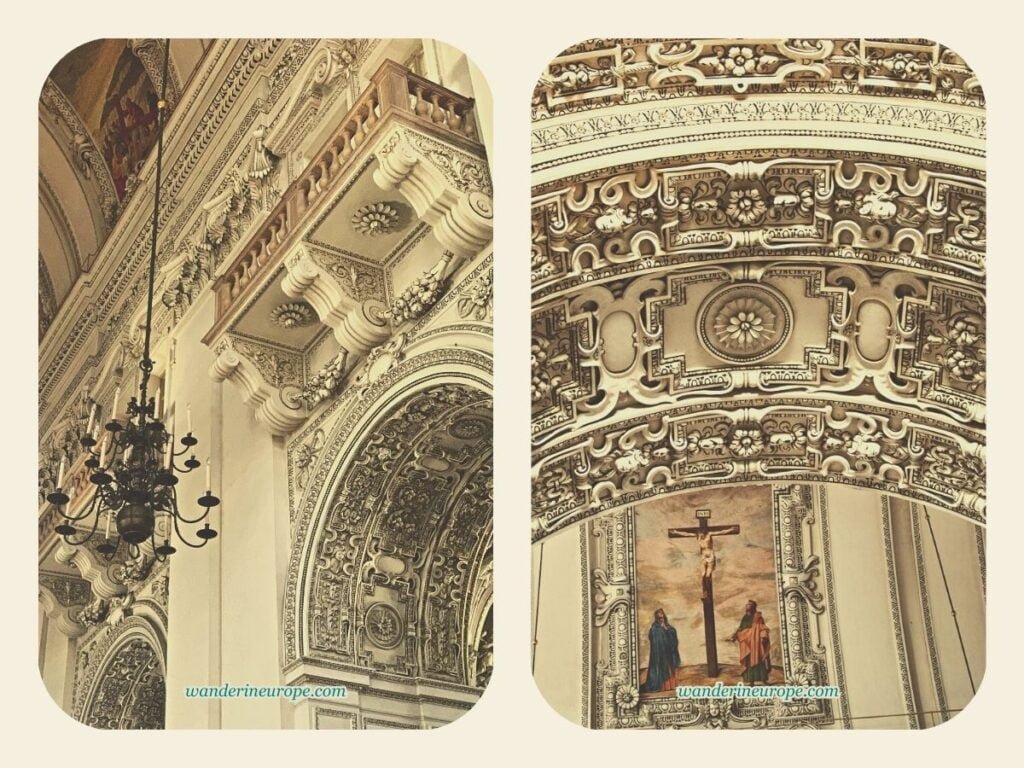

And I believe it will also be the first part of the church that will catch your eyes as you enter for the first time. But, of course, there’s more beauty to see inside Salzburg Cathedral.
In this part of the post, I’ll tell you what you must not miss. I’ll mention them in the same sequence that I learned about them using the cathedral’s audio guide. But, overall, if you enjoy marveling at old world architecture, discovering little travel gems, and stumbling upon symbolic and religious artworks, then you should prepare to spend an hour (not more than two) inside Salzburg Cathedral.
Here’s where you can get your entry tickets & audio guide or entry tickets (guided tour) to Salzburg Cathedral.
Entrance Area
I’m not sure if there are other more entrances to Salzburg Cathedral but most probably, you’ll be entering the church through its main portals. If that’s the case, you’ll be at the main entrance area which is also the best place in the cathedral to appreciate the grandeur and rich history of Salzburg Cathedral.


What to do in the entrance area
So, here, I encourage you to take a moment to soak in the atmosphere and admire the gorgeous architecture, unique balconies, and marvelous, intricate stucco decorations. Spacious and elaborate, you’ll definitely feel the ceremonial ambiance of the church.
Look up to see the first story-telling features of the Salzburg Cathedral, framed by the stuccos: the paintings by Florentine painter Arsenio Mascagni. These large-scale frescoes depict the Passion of Christ, culminating in the resurrection, which is displayed at the front of the high altar. Here, you can see the role of art in conveying religious and spiritual messages, and the power of visual storytelling to inspire and move people.
On the left side of the entrance area, you’ll see a large stone block with photographs of the cathedral after it was severely damaged during World War II. At this point, I felt a sense of sadness or loss at the destruction of such a beautiful and historic building.But, at the same time, I was impressed by the resilience and determination of those who worked to restore the cathedral to its former glory.
Here, you may reflect on the impact of war and conflict on cultural heritage sites and the importance of preserving and protecting these landmarks for future generations.
Baptismal Font
After the entrance area of Salzburg Cathedral, the next most fascinating part of the church you can quickly see next is the baptismal area, located in the first side chapel on the left. As you approach it, you’ll likely notice first the beautiful altarpiece depicting John the Baptist baptizing Christ in the Jordan River. But the real treasure here is the magnificent baptismal font, dating back to the 14th century and resting on top of lion sculptures from the 12th century.

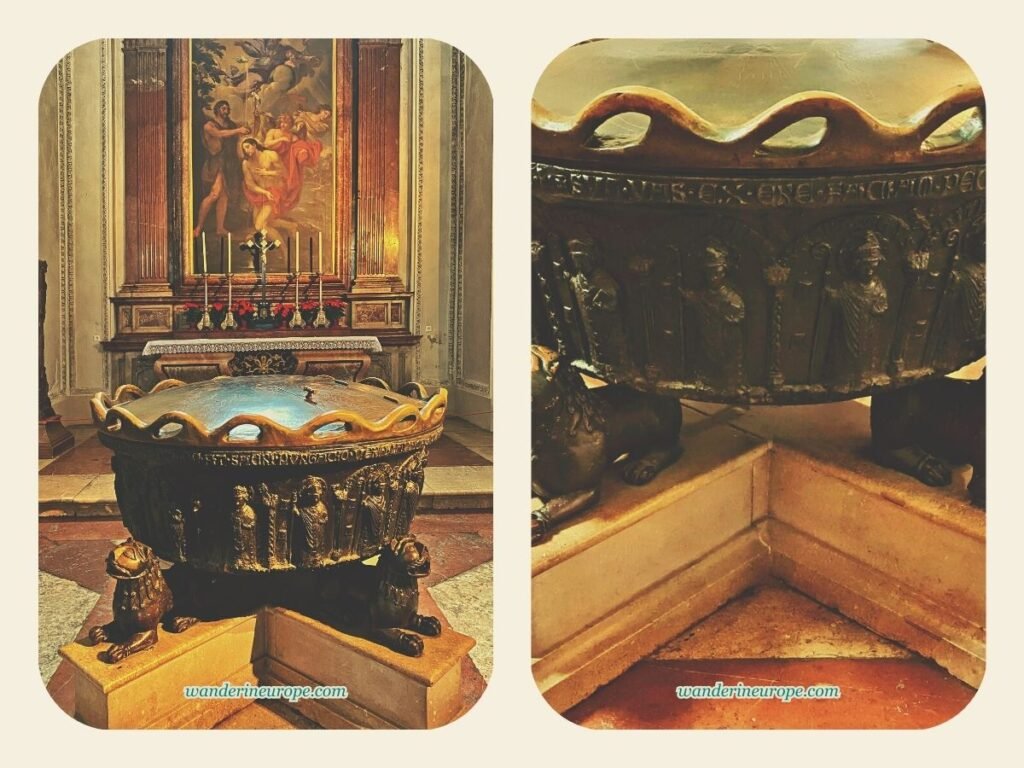

Learn more about the Baptismal Font
If it’s hard to believe that it’s that old, take a moment to walk around the font and read the inscription along its upper edge: “I am a vessel made of all. I redeem sins. True purification in the holy water happens through me. All that is washed in baptism undergoes complete purification. Master Heinrich made me in the Year of Our Lord 1321.”
That old, I can’t imagine how many babies were baptized in Salzburg Cathedral’s baptismal font already. And here’s a fun fact: one of Salzburg’s most famous citizens, Wolfgang Amadeus Mozart, was baptized right here in this cathedral on January 28, 1756. His full name, Johannes Chrysostomus Wolfgangus Theophilus Mozart, is recorded in the baptismal register for all to see.
Stuccoes and Pews
More beautiful sights await you in Salzburg Cathedral, even in areas and aspects you’d never imagine. Like on the ceiling and pews of this church.


More about the Stuccoes and Pews
As you stand in the baptismal area of Salzburg Cathedral, don’t forget to look up. You’ll be struck by the beauty of the chapel ceiling and inspired to capture the moment with your phone or camera. The side chapels boast intricate stucco work that’s even more impressive than what you’ll see on the ceiling of the church’s longhouse.
At first glance, it might be hard to see what makes these stucco works so special, but take a closer look and you’ll notice that the contours have been emphasized with gray paint, giving them a stunning three-dimensional appearance.
If you have a powerful camera with a 10x zoom, you can get an even better view. After admiring the chapel ceiling, make your way to the longhouse of the church. Here, you’ll find the cathedral’s beautiful pews, which can seat 600 people during well-attended services on high ecclesiastical holidays. Fun fact! While the pews can only accommodate hundreds of people, the entire Salzburg Cathedral can hold up to 5000 people for events like Easter, Christmas, Whitson Tide, and diocesan occasions such as ordinations of priests.
Gates
Before heading to the high altar to explore more of Salzburg Cathedral, take a moment to check out the three large bronze gates. These gates represent the three divine virtues of faith, hope, and love. Adorned with intricate reliefs on their outer sides, they were created by three renowned artists and consecrated in 1958



Learn more about the gates of Salzburg Cathedral
The largest gate in the middle, the Gate of Love, features reliefs of Saints and blessed individuals who embodied the commandment to love your neighbor as yourself. Among these figures are the patron saints of Salzburg, one depicted sharing his coat with a beggar and another comforting a woman in need.
The Gate of Faith, which tourists enter through, has a central figure of Paul, who was converted to believe in Christ. Other scenes on this gate show examples of firmness of faith and having one’s faith put to the test. The door handle is shaped like a cross, symbolizing that one must go through Christ to become part of the community of the faithful.
The Gate of Hope is then a tribute to humanity’s hope for salvation. In the center, above a pyramid of flowers, the Annunciation to Mary is depicted. Choirs of angels surround the hand of God, pointing at Mary, with a sun on the hand representing Christ, the light of the world. At this point, if you’re also a Catholic like me, you may want to reflect on how each gate represents a different virtue and how the scenes depicted on them illustrate those virtues in action.
Otherwise, you can simply appreciate the unique artistry that went into creating these gates and their reliefs.
Domed Space
Another breathtaking sight in Salzburg Cathedral can be found below the largest dome of the church, where the longhouse and transept intersect. Step into the center of the octagonal tiles below the dome and look up — you’ll be amazed by the architectural work that combines form and light to depict a religious scene.


Interesting facts about the Cathedral’s dome space
Above you, at the highest point, a depiction of the Holy Ghost in the form of a dove soars with a wingspan of about two meters, situated at an impressive height of 65 meters. The light pouring in through the windows of the octagonal dome illuminates the space, giving the dome a divine appearance. From this spot, you can also see the arms of the transept open to your left and right, revealing the cross-shaped layout of the building.
In front of you towards the east lies the chancel, also known as the presbytery or sanctuary. As you turn around, your eyes will be drawn to the West Gallery, home to the largest organ in the cathedral with its over 4000 pipes.
Interestingly, beneath your feet lies the crypt of the cathedral. It’s thought that it was placed there intentionally so that the archbishops who rest in the crypt can find light from the Holy Spirit at the tip of the dome. You can find your way down to this hallowed ground by taking the stairway next to the left-hand side altar.
Before proceeding to the crypt, have another few more moments near the domed space to appreciate the majestic high altar and organs of Salzburg Cathedral.
High Altar
Like most churches, the high altar of Salzburg Cathedral is the grandest religious work of art you’ll find inside. But it’s more than just a beautiful piece of art — it captures the essence of the Christian faith and more.

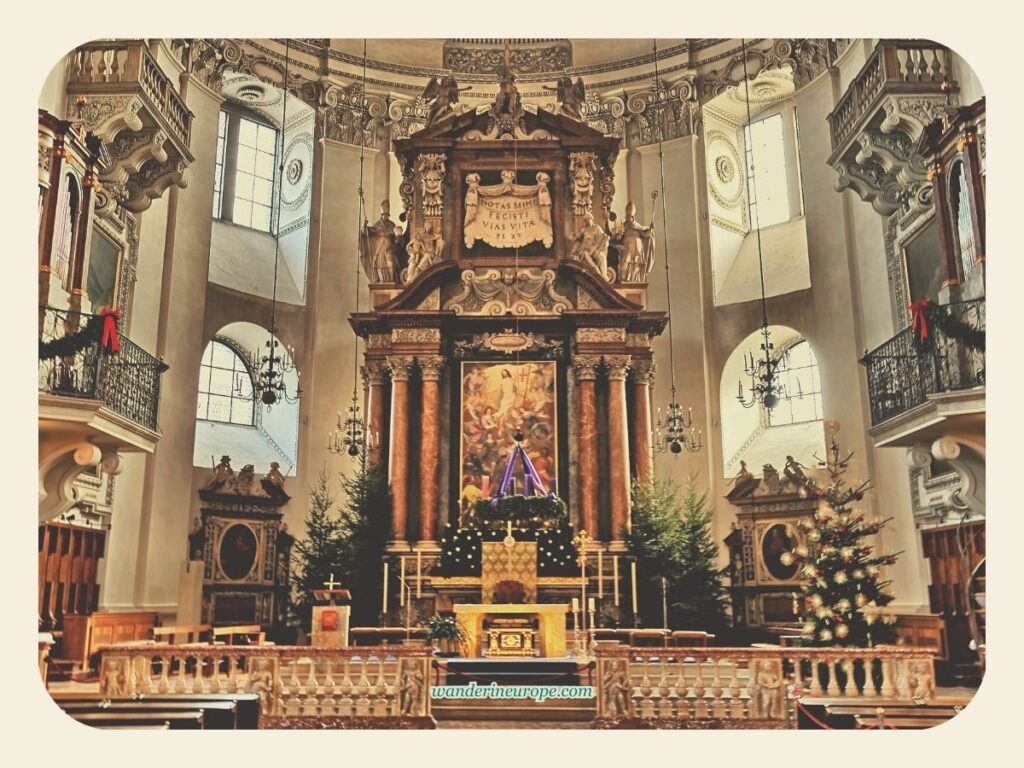

Interesting facts about the High Altar
Take a moment to appreciate the massive high altar towering above you, with its altarpiece depicting the greatest miracle of the Christian faith – the resurrection of Jesus Christ. Also, the inscription above the high altar painting reads “NOTAS MIHI FECISTI VIAS VITAE”, meaning “you have shown me the ways of life”.
The altarpiece painting and the inscription give hope to the faithful that they too will be reborn, following in the selfless and loving ways of Jesus. Displaying the Christian virtues of faith, love, and hope, the extension of the high altar further emphasizes this message of resurrection.
The high altar in Salzburg Cathedral also features images of saints who guide the people of Salzburg closer to God — including statues of the patron saints, Rupert and Virgil. Immediately in front of the high altar, a large chair catches your attention. This is the Cathedra – the seat of the Archbishop, who is the spiritual leader of the Archdiocese of Salzburg. From this seat, he leads his congregation and guides them on their spiritual journey.
Organs
Let your eyes wander around for a few more moments while you are within the domed space, especially as it offers the best view of the magnificent organs of Salzburg Cathedral. Did you know that Salzburg Cathedral is home to several magnificent organs?

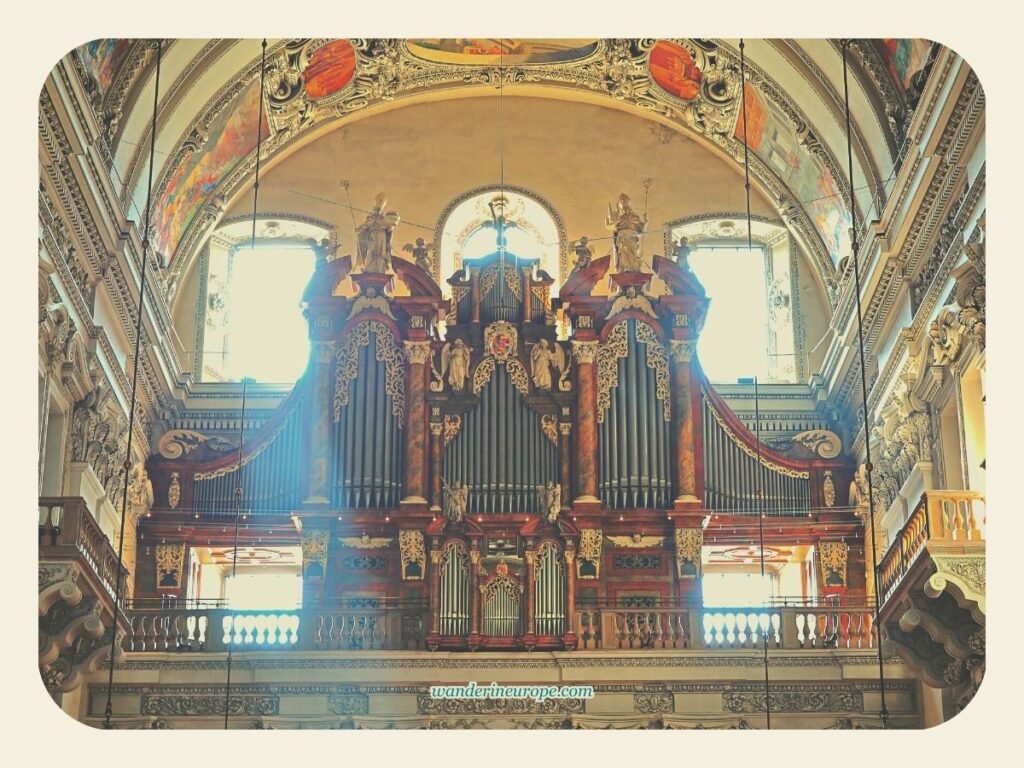

More about Salzburg Cathedral’s Organs
Be sure to take a moment to admire the four stunning pillar organs perched atop the pillars supporting the dome. Two of these magnificent instruments are crafted in the South German and Austrian baroque tradition, while the other two boast a classical Italian style.
And that’s just the beginning – there’s also a grand organ in the West gallery (as I have mentioned previously) and a delightful small chest organ in the chancel. With over 8000 pipes at their fingertips, the skilled organist can create a truly divine sound that fills every corner of the cathedral with heavenly music.
Today, the choir of Salzburg Cathedral, using these organs, is a harmonious blend of the Cathedral Choir, youth choirs, soloists, and an orchestra, boasting over 200 talented members. With their angelic voices and masterful instrumentation, they perform about 50 Masses in various formations and enchant audiences with ten concerts both within Germany and beyond its borders.”
Fun fact! Did you know that Mozart himself often played on the southeastern pillar organ, the “Hoforgel”, in the Salzburg Cathedral?
Crypt
After exploring all the amazing parts of Salzburg Cathedral mentioned above, you’re almost done with your tour of the church. But don’t forget to check out the crypt! As you explore the crypt, you’ll discover more than just the final resting place of the archbishops.


What to expect in Salzburg Cathedral’s Crypt?
On the right-hand wall, you’ll find a fascinating map that reveals the complex architectural history of the cathedral. Layer upon layer of ground plans showcase the evolution of the building we see today. It should give you a deeper understanding of the cathedral’s past and how it has changed and grown to become the magnificent structure we see today.
Beyond the burial chamber lies the Adoration Chapel, a sacred space for private prayer. While it may be tempting to take a peek, please respect its sanctity and refrain from entering for sightseeing purposes.
Artwork Vanitas
Another part of Salzburg Cathedral’s crypt is the Romanesque crypt, where you are transported to a world of mystery and reflection. In 2009, this hidden gem was uncovered during construction work outside the cathedral and made accessible to everyone. In that year, as part of the Salzburg Art Project, artist Christian Boltanski was invited to create an installation that would inspire people visiting the cathedral — the “Vanitas”


What to expect + meaning of the Vanitas
Comprised of three elements – a time announcement, a rotating light projection, and 12 metal figures – the artwork is brought to life by the flickering of candles in front of the figures. As you pass by, the movement of air causes the flames to dance, casting enchanting shadows on the wall and creating a mesmerizing display before your eyes.
But what’s the deeper meaning behind this stunning piece? Christian Boltanski’s intriguing installation is a powerful reflection on the transience of life. “Vanitas” encourages you to reflect on your limited time in this world and how you can make the most of it. So, after visiting the crypt, you can take a renewed sense of purpose and a reminder to cherish every moment.
The installation is intimately connected to the resurrection of Christ on the high altar and the inscription above it, “NOTAS MIHI FECISTI VIAS VITAE,” which translates to “you have shown me the ways of life.” Ultimately, the “Vanitas” tells that life is truly fulfilled when you follow Jesus’ example of love and compassion.
The Facade and Other Chapels
Once you’ve explored the places mentioned and the crypt of Salzburg Cathedral, you’ve seen one of the most unique parts of the church. But there’s still more to discover. Check out the facade of the cathedral, Chapel of the Tabernacle and the Old Baptismal Chapel.


Details about the facade and other chapels
If you like you can check the Chapel of the Tabernacle or the Old Baptismal Chapel. In those side chapels, you can witness Catholics practicing their faith: lighting the candles, venerating the saints, and other more.
Actually, the facade of Salzburg Cathedral has some interesting features, too. Based on what I heard from the audio guides, the facade of the Salzburg Cathedral is designed to tell a religious story. It’s like a book about the Christian faith, with the facade being the cover and the start of the story.
When you look at the center of the facade, you’ll see a figure of Jesus Christ. There, He is shown as the one who saves the world. Around him are two important prophets from the Bible, Moses and Elijah. Together with the white color of the facade, these figures represent a scene from the Bible where Jesus appears to his followers in a bright light. This event is called the Transfiguration and it is a preview of Jesus coming back to life, which is the main message of the Christian faith.
The middle field of the facade of Salzburg Cathedral contains the four Evangelists, including Peter and Paul, who are considered to be archetypal missionaries. The Evangelists are the authors of the four Gospels in the New Testament, which contain the teachings and life of Jesus Christ.
On the other hand, Saint Peter and Paul were two of the most prominent apostles and played a crucial role in spreading the teachings of Jesus. On the outside, they are flanked by the statues of saint Rupert and Virgil, highlighting the role they played in establishing the church in Salzburg and spreading Christianity in the region.
Concerts
A beautiful experience inside Salzburg Cathedral
In the beginning, I’ve mentioned that Salzburg Cathedral offers not only experiences relating to architecture and religious heritage, but also music. Every day, except Sundays and public holidays, you have the opportunity to immerse yourself in the unique organ landscape of Salzburg Cathedral with up to seven of its organs.
The organs were designed with great care and attention to detail, following the principles of classical architecture and proportion theory, creating a harmonious unity between the organs, altars, and the prospect of the large organ. Listening to a cathedral organ concert in the Salzburg Cathedral would be a unique experience, as you would be able to appreciate not only the music but also the harmony between the organs and their surroundings.
As the bells ring at about 12:04 p.m., two talented organists bring the different organs and organ combinations to life, filling the cathedral with rich and diverse sounds. The concerts last for about 25 minutes, providing a perfect midday escape into a world of musical bliss. Doors open at 11:40 a.m., so make sure to arrive early to secure your spot for this unforgettable experience. (There’s no seat reservation)
You can check the price of the Organ Concert in Salzburg Cathedral here.
Visiting Information
What are the opening hours of Salzburg Cathedral?
From Monday to Saturday, Salzburg Cathedral accepts visitors from 8:00 am until 5:00 pm (January and February, November) / 6:00 pm (March to July, September to October, and December) / 7:00 pm (August). During Sundays and public holidays, the opening hour is 1:00 pm.
Please note that the opening hours of Salzburg Cathedral may vary during church and city events. For the most up-to-date information, please visit the cathedral’s official website, which is linked in the resources section of this post.
Entry to Salzburg Cathedral (is it free?)
You will need to pay a few euros to enter, but the fees collected are used to maintain the church. Here’s where you can check the current prices of entry tickets (with audio guide) or entry tickets (guided tour) to Salzburg Cathedral. If you want to be guided privately to the Salzburg Cathedral and other highlights and most beautiful parts of Salzburg like Mirabell Garden, Fortress Hohensalzburg, Getreidegasse, and Mozart Birthplace…
…you must be looking for this Private City Highlight Tour with a Guide in Salzburg.
In the tour, you will embark on a 3-hour adventure through the city of Salzburg and discover its hidden gems and secrets. It’s an insider’s tour that will provide you with valuable tips on how to make the most of your vacation, while also regaling you with fascinating historical facts and amusing anecdotes about this charming city.
Resources
If you’re interested in learning more about the Salzburg Cathedral, including the latest news, I’ve gathered some resources for you. I recommend checking them out before your visit to the cathedral.
- Official Website of Salzburg Cathedral
- Opening Hours of Salzburg Cathedral
- Salzburg Cathedral Full History
If you’re planning a trip to Salzburg and still need accommodations, I’ve got you covered with the best hotel deals in the city. By using this affiliate link to my partner’s hotel and booking platform, you’ll not only secure a great place to stay, but also support WanderInEurope at no extra cost to you. Each booking made through this link provides a small commission that helps maintain and create new, helpful posts like this one. Your support is greatly appreciated. Thank you!

Salzburg offers more than just its stunning historical landmarks like the cathedral. I’ve uncovered unique experiences and viewpoints in Kapuzinerberg and Mönchsberg that are simply perfect for catching the city’s sunrise and sunset. If you’re planning to stay for a few days or longer, consider taking a day trip. There are several destinations just a short train ride or drive from the Old Town. I highly recommend the quaint village of Saint Gilgen, the time-transporting Hohenwerfen Fortress, the breathtaking Berchtesgaden, and Hellbrunn Palace.
Links open in a new tab.


